Category Archives: Aquarium DIY
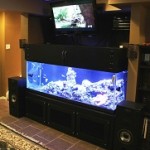
Building a Aquarium Canopy
I had a few requests to write up ideas with pictures of how to build a aquarium canopy.I thought I would just show and explain how I built some of the canopies that I have used in the past. The first two examples are based on a canopy that I had seen on a 190 gallon aquarium owned by a fellow hobbyist and friend.
Before building your canopy, I would recommend that you first have your lighting you are going to use on the aquarium. You will need to know how far above the aquarium you will want to use your lighting, how thick the lighting fixture is, and how long the lighting fixture is. Sometimes it is helpful if you can use your lighting on the aquarium for a while so you can try out the lighting and confirm how high you want the lighting from the top of the aquarium.
Canopy Example #1
This first example is a canopy that I built for a four foot 90 gallon aquarium.I started by building the frame that sits on top of the tank. The outside measurements of this frame are the same as the outside measurement of the aquarium. My lighting will not be wider than the aquarium so I can use those dimensions for this build. I used 2X2 inch lengths of solid pine for the back and sides and a ¾ by 4 inch length of solid pine for the front.I used construction grade wood screws and generous amounts of wood glue to attach the frame pieces together.
On this frame piece you will only see one angled support on the right hand side back corner.I could not add angled supports on both back corners as the aquarium has an internal overflow on the back left hand corner and I wanted to leave as much room as I could for access to the overflow. If the aquarium did not have an internal overflow, I would have added angled supports to both back corners
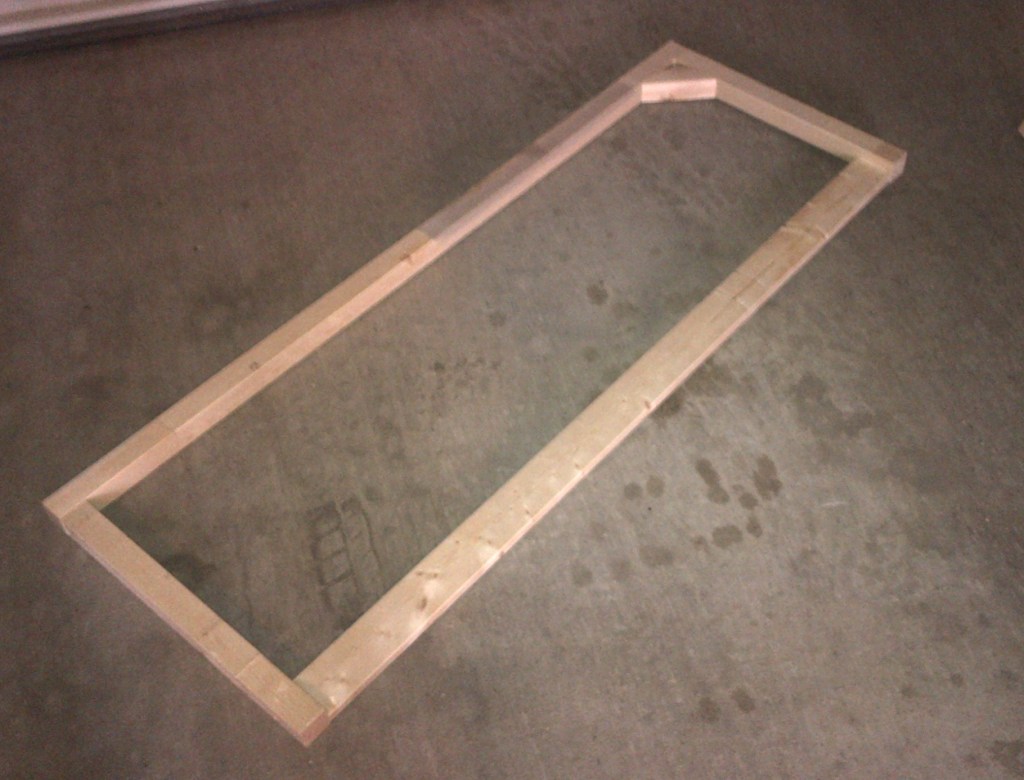
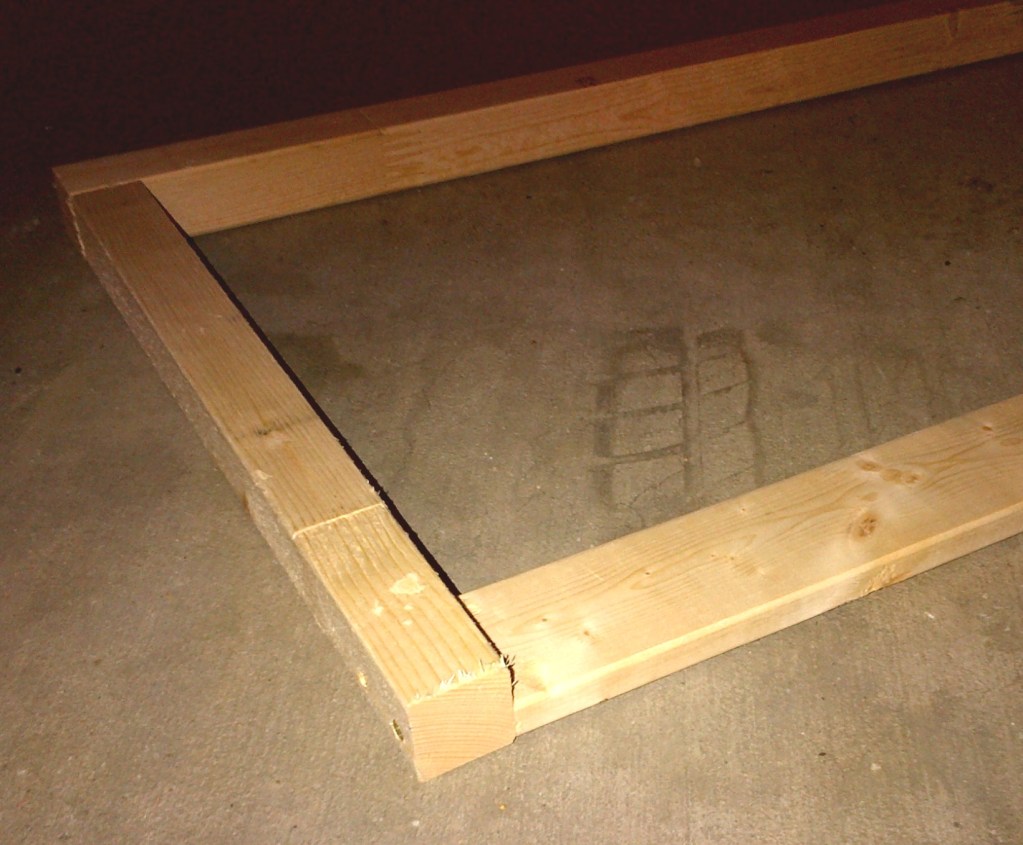
I then added the back piece to the frame (using wood glue and screws). The paneling that I used for this was ¾” solid pine. I pre-drilled holes for the screws to help ensure I did not split the wood. When working with wood 2 inches and less in thickness, I always prefer to pre-drill before using construction grade screws. When working with a softer wood like pine, you may not have to pre-drill your holes.This is just my preference
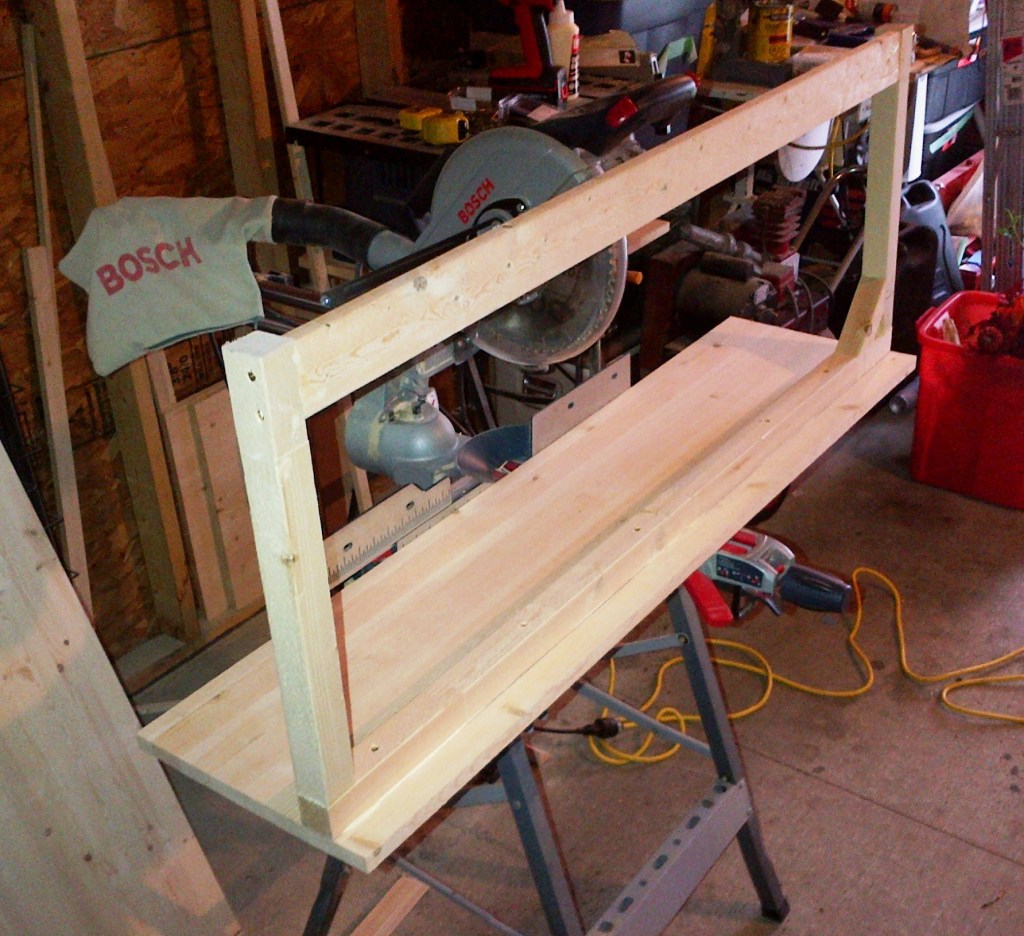
The sides were added next.As you can see from the below and above pictures, I attached the sides and back from the inside of the canopy and not from the outside were ever possible. That way, the screw heads will not be visible from the outside of the stand so I don’t have to spend as much time filling the holes to hide them later on. The back and side pieces also go 2 inches down past the frame to allow the sides and back to fit around the aquarium preventing the canopy from being accidentally knocked off the aquarium. This also covers the black trim of the aquarium giving it a nicer or at least a more consistent look
As I am using LED lighting I knew that I wanted to have them 6 to 8 inches above the aquarium, and the LED fixtures are 2 inches thick with 1 to 2 inch thick mounting bar (depending on the exact type that I choose to use). I left 10 inches of space above the frame to allow enough space inside the canopy for my lighting and air circulation around the lighting
That is why I used 14 inch wide boards for the back and sides: 10 inches of space above the frame, 2 inches of space for the frame, and 2 inches of space below the frame
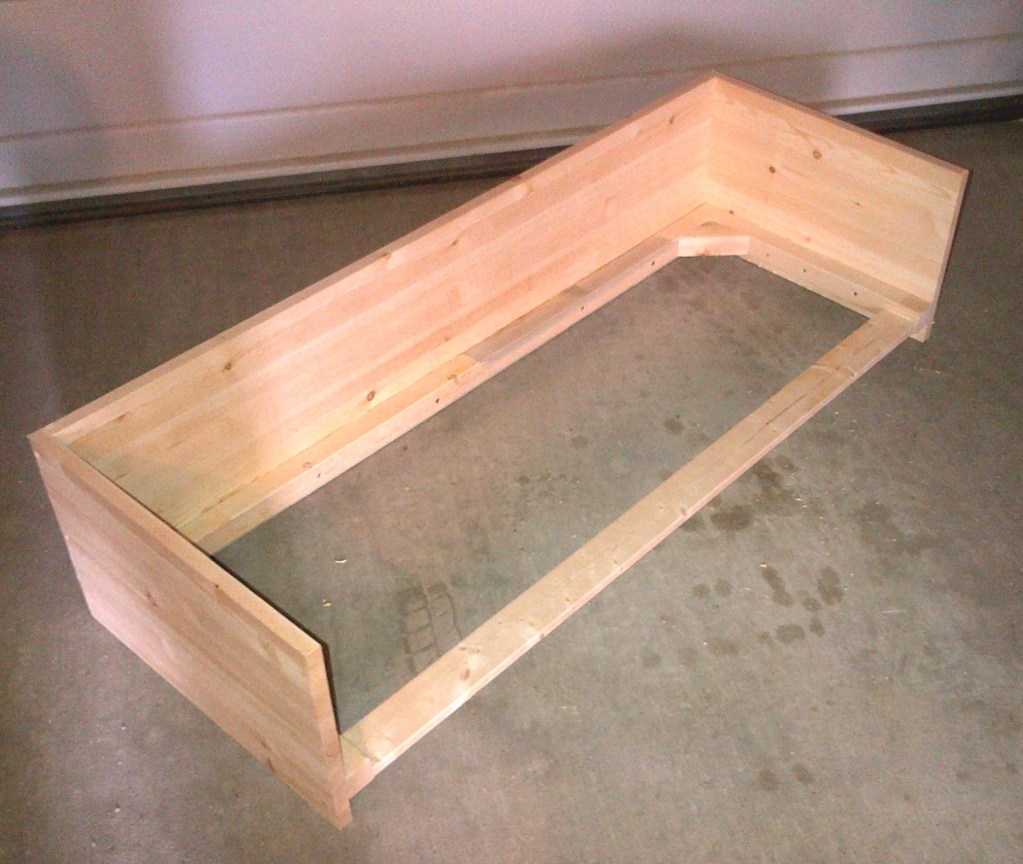
I then cut and attached a piece of wood that covered about 80% of the top of the canopy, leaving about 20% of the top open at the front.
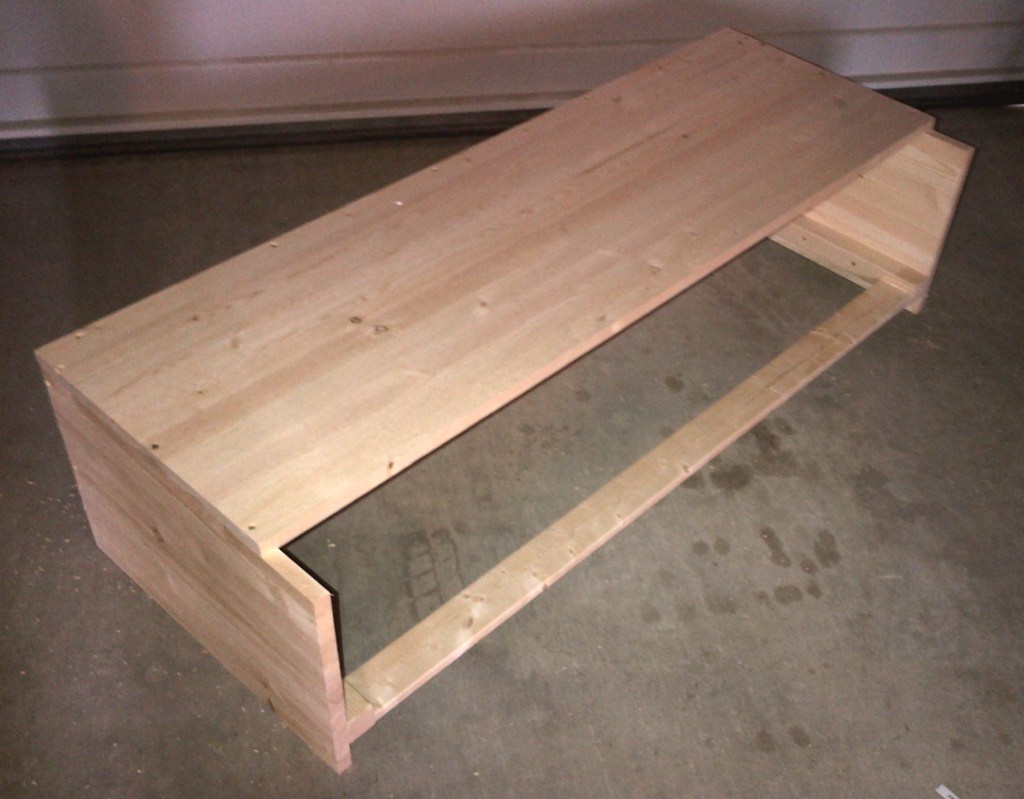
I built the lid next and dry fit it to make sure I got it right. I built an “L” shaped lid so the hinge will sit on the top of the canopy were it will be out of sight. The front of the door drops down 2 inches past the frame so it will match the sides and back of the canopy.
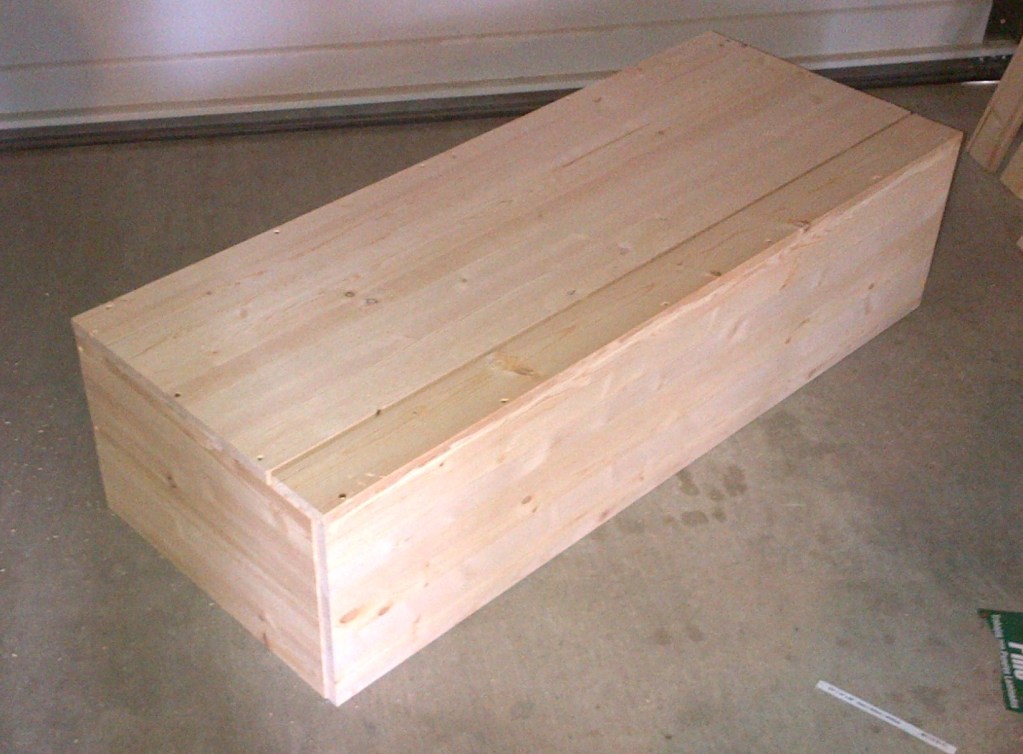
As you can see by the below picture, I used four angled supports to re-enforce the two pieces of the lid.
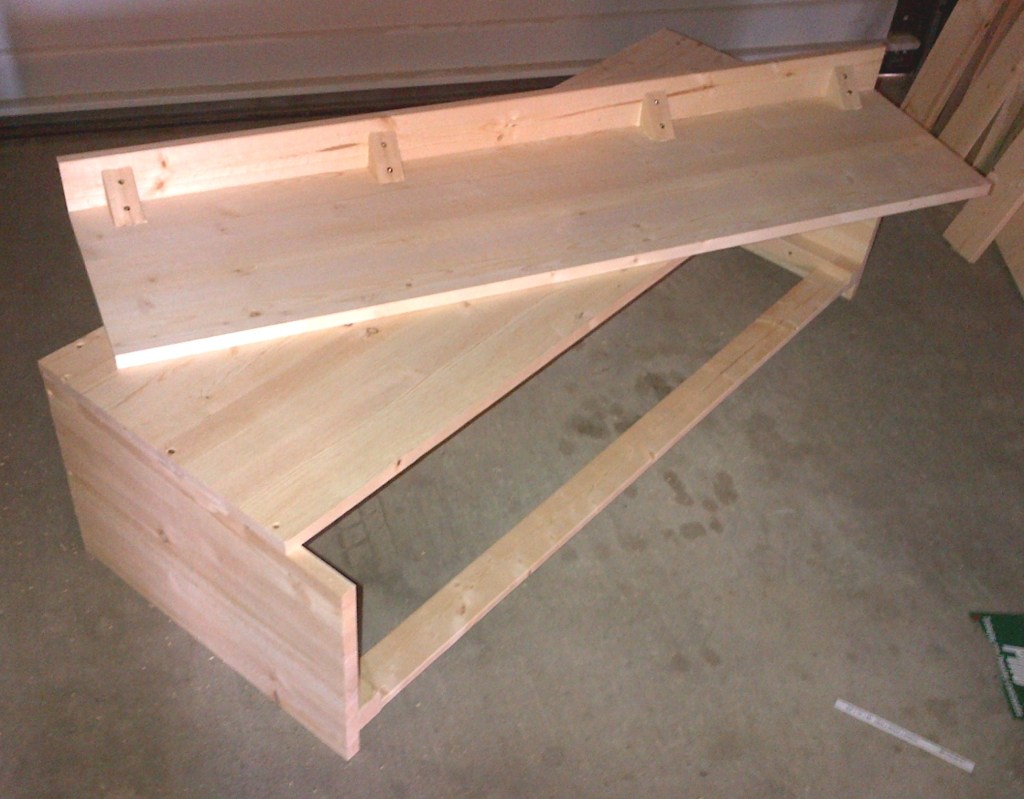
The next step was to drill the vent holes on the sides, top and back, and put in the rails for the LED mount bar I made. I also added a little trim to the sides to give it a little better look. The inside rails can also be used for a T5 light fixture as well. The second example that I have in this article shows these rails in better detail.
After some wood filler, two coats of a good quality primer & sealer, and 3 coats of a marine based paint, the canopy was complete. You can also use a very good quality primer and sealer followed by a very good quality exterior paint if you do not want to use a marine based paint. I had to let the paint cure before I put it on the aquarium. I painted the inside with the same black paint as I did not want to buy two different colors of marine paint
I chose to paint this canopy black so it would match the stand the aquarium was sitting on. I like to give my set-ups a more consistent look as well as matching with the rest of the furniture in the room, but that is just my preference. You can finish your canopy to suit your tastes.
Here are a few pictures of the finished product.
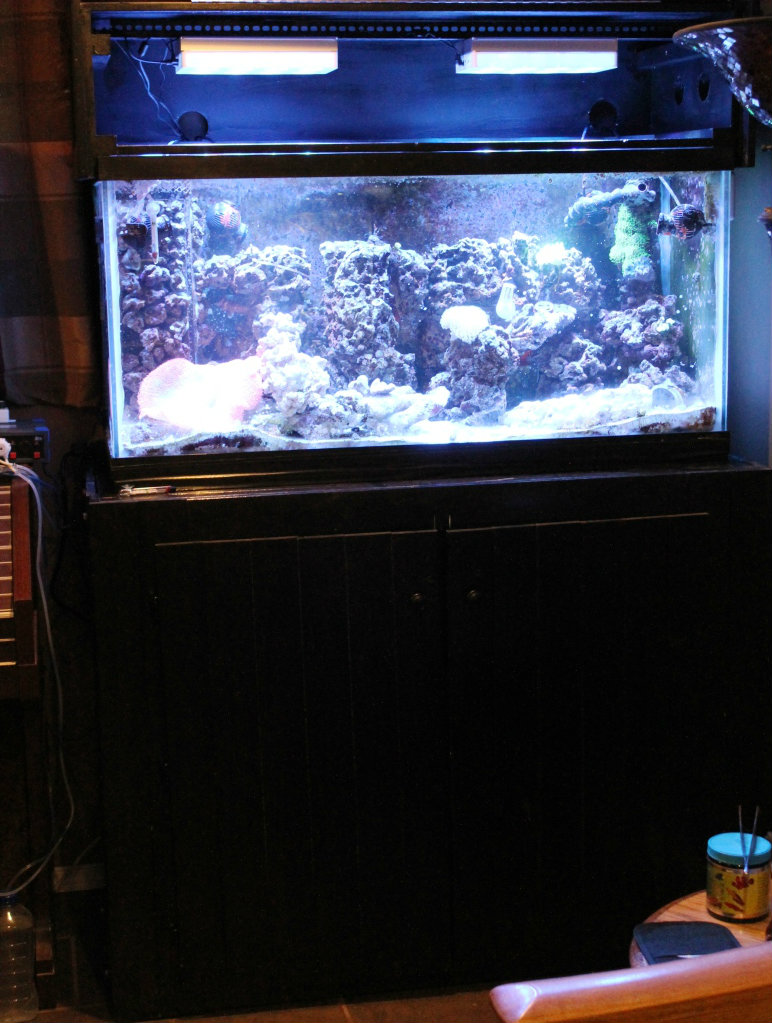
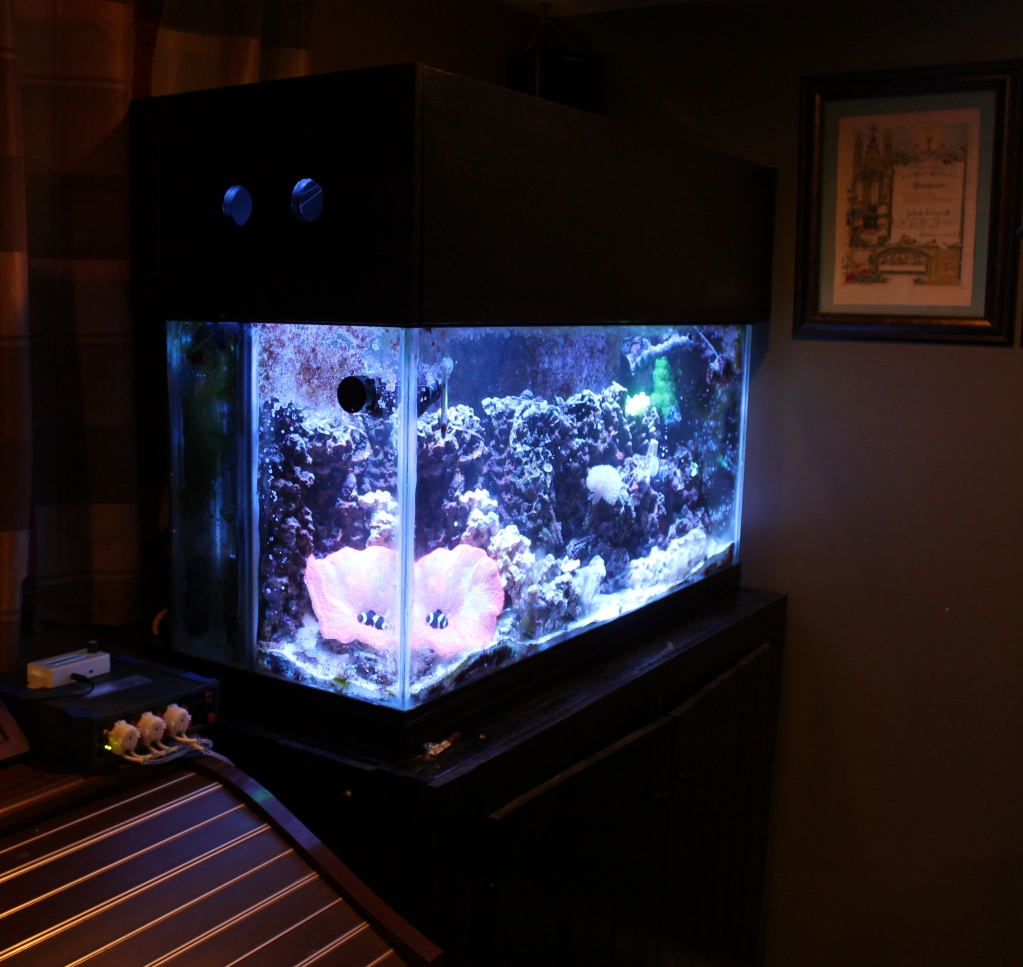
Canopy Example #2
The second example that I am showing here is one that I built for a four foot 120 gallon aquarium that I have. I wish I had taken more photos while I was building it, but this will give you a pretty good idea. I followed the basic same design as the first canopy that I showed in this article. The biggest difference is that I stained and urethaned this canopy and extended the top of the door to the center of the top of the canopy to allow for more room to reach into the tank to complete routine maintenance when needed. The only drawback to this is that it makes the door heavier as compared to the door in the first example.
In these pictures you will see a little more detail on a few features not shown very well on the first example. I also drilled two air holes on each side of the back piece near the corner to run cables through for the poweheads, lighting, and what not. I made these holes a little larger than the rest of the air hole to make it easier when running cable through them. You can also see the vent holes that were drilled on the top of the canopy for additional air circulation.
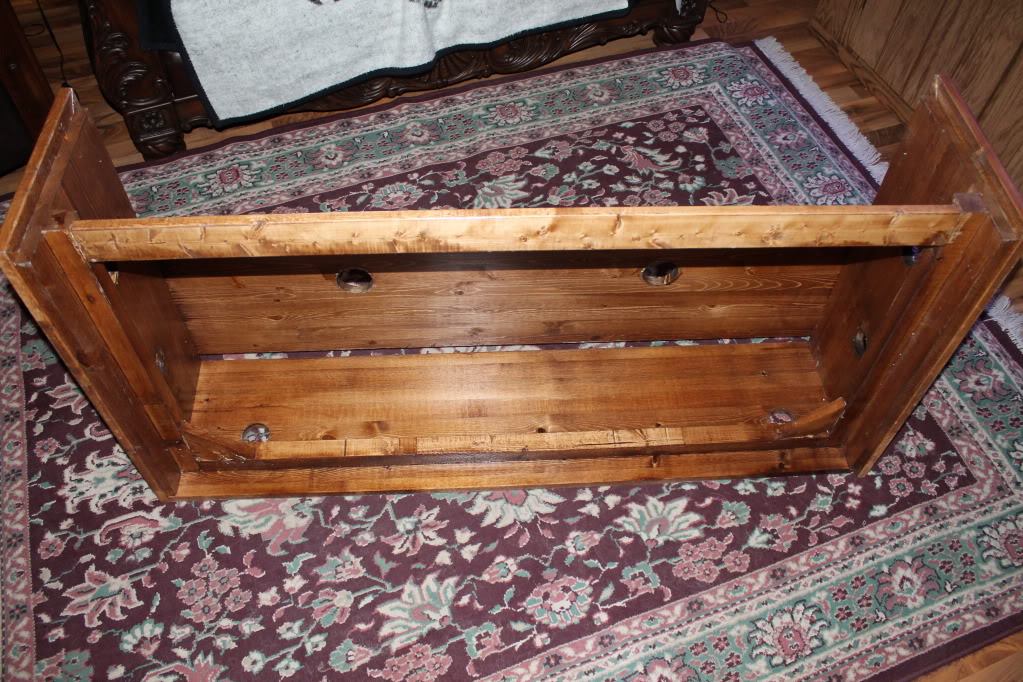
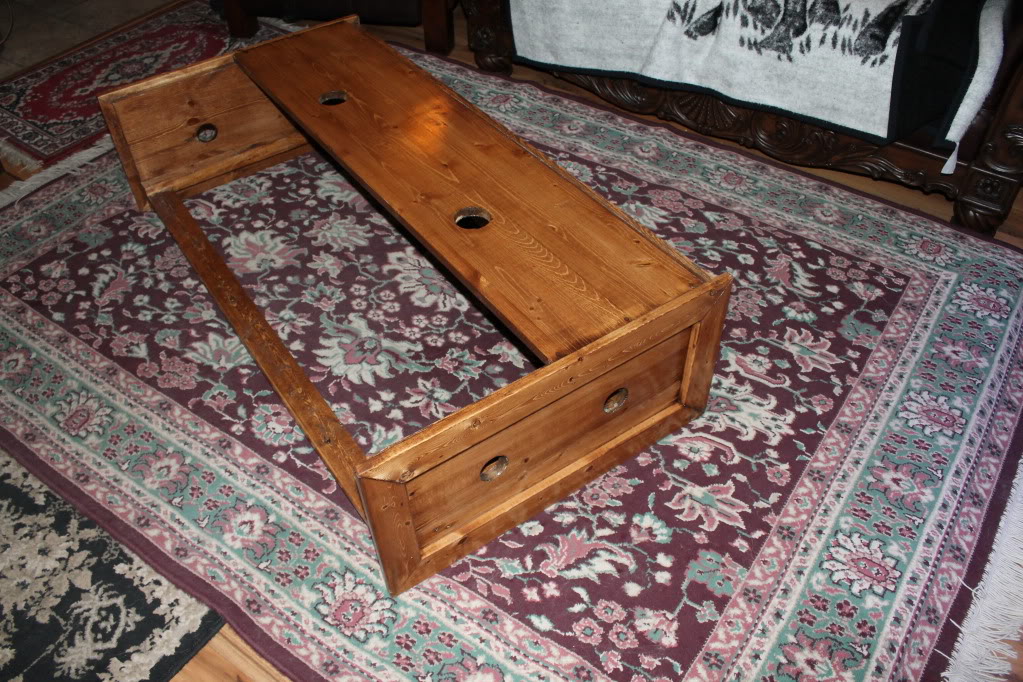
Just as with the first canopy, I used the same thickness of solid pine and I glued and screwed everything together in the same way. I stained this canopy to match the stand and furniture in the room followed by several coats of urethane (4 or 5 if I am remembering correctly).
One of the last things that I had done was to add two pieces of wood on the inside of each side for the mounting bar of my LED lighting to sit on. You can also adjust the height of this wooden rail to allow for a T5HO fixture.
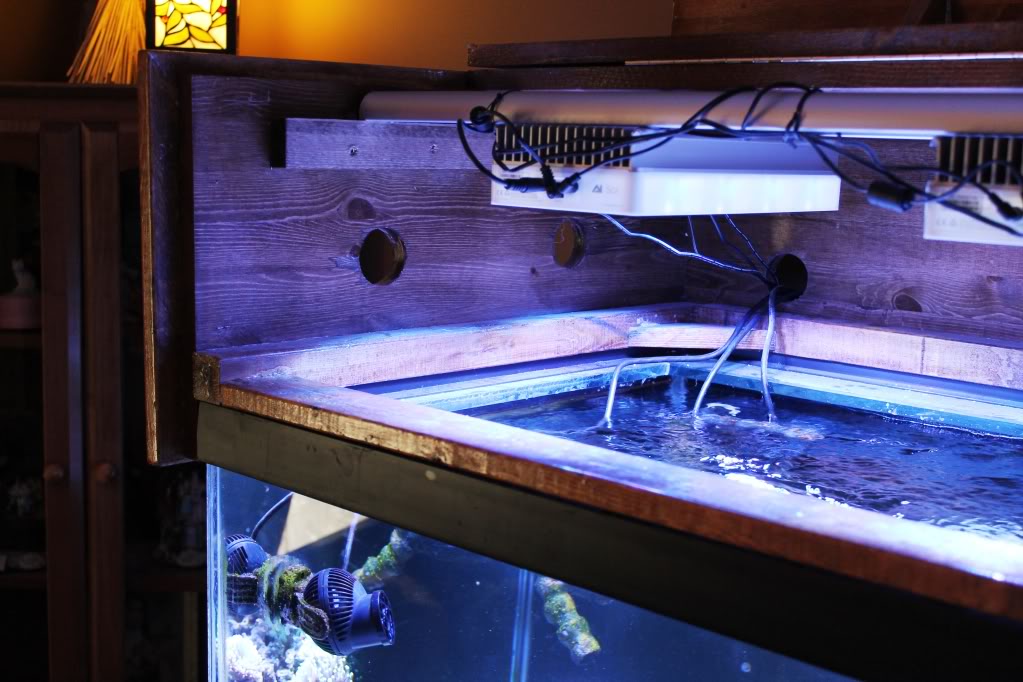
I had to make sure the angled supports on the back corners of the frame would not extend further past the top bracing of the aquarium or they would restrict my access to the internal overflow.You can also see the side trim pieces that I added to give the canopy a more finished look and to also hide any light that might come through around the door.
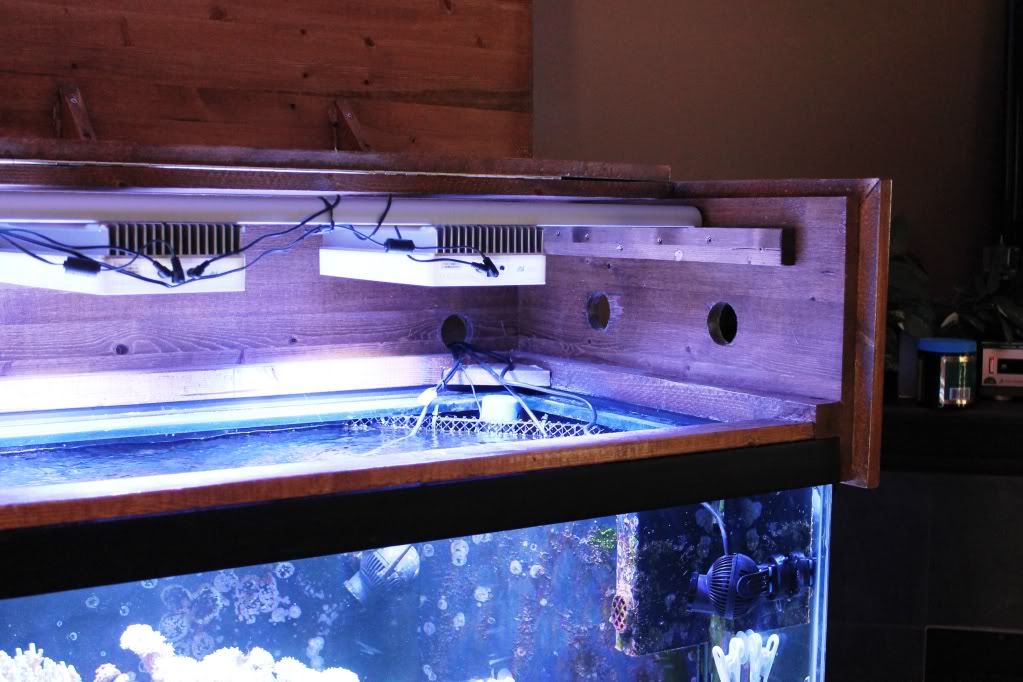
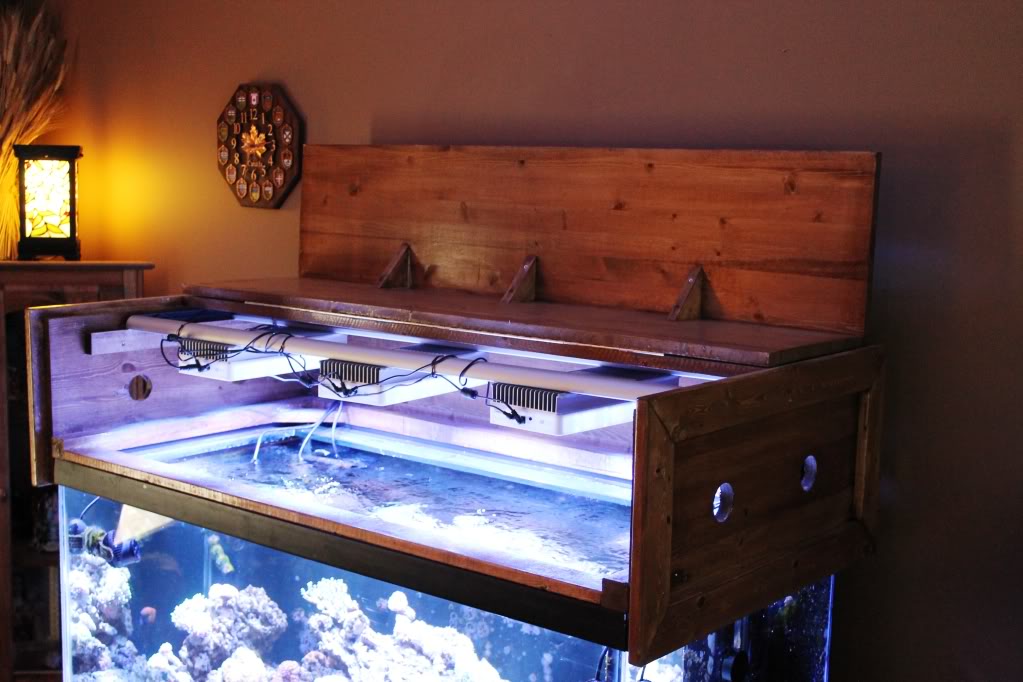
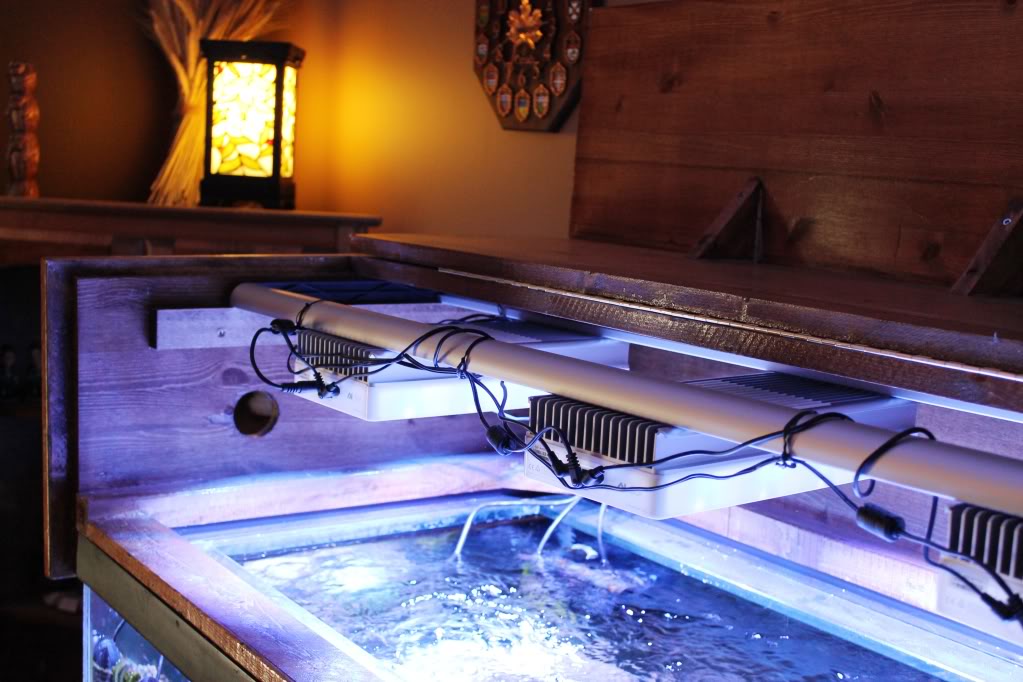
If you are using T5HO or MH lighting I would certainly recommend more and larger vent holes and possibly adding a built in vent fan or two. I would also design the canopy for extra space inside the canopy for better air movement to help the lighting stay cool. You will have to be extremely careful using MH lighting in a canopy due to the very high levels of heat produced by an average MH fixture. As I use LEDs in my canopies I do not need that many vent holes as they produce low amounts of heat.
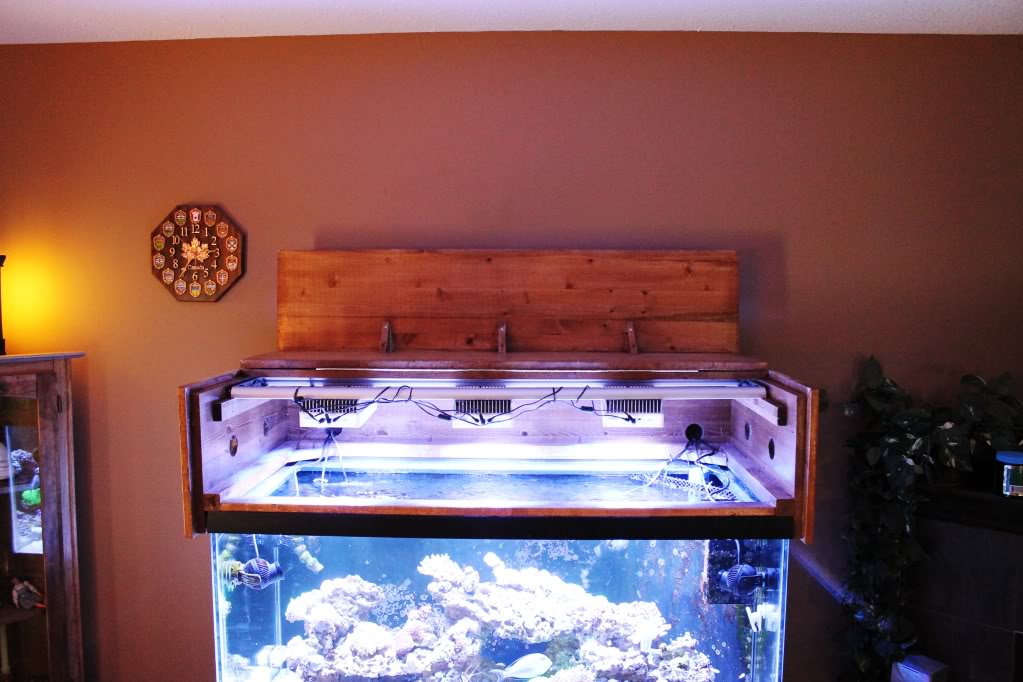
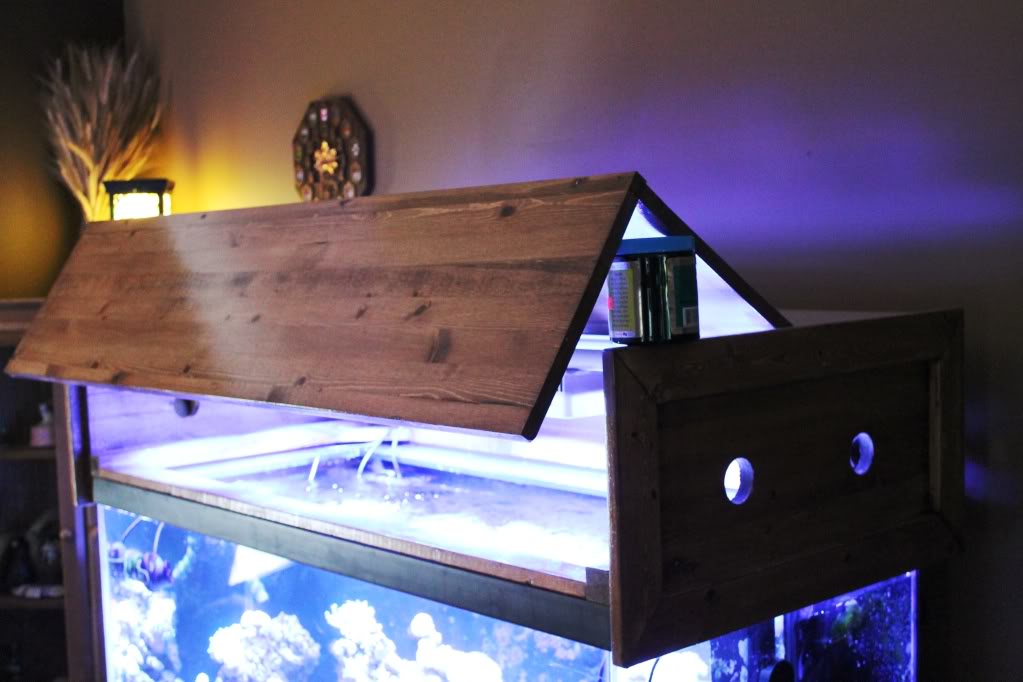
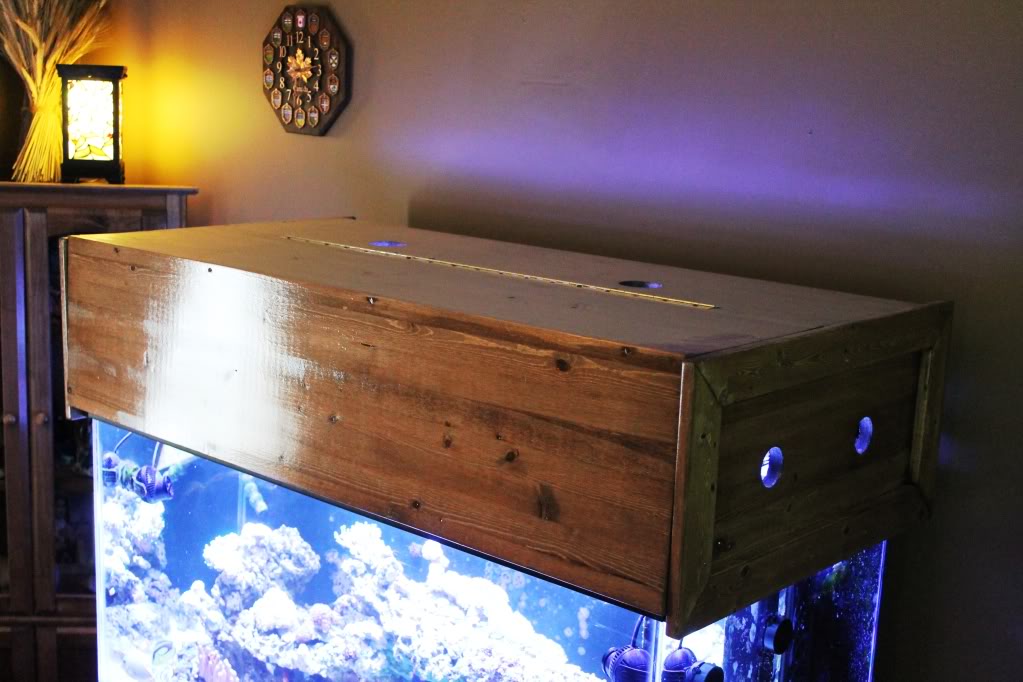
The below is a picture showing the air vent covers that I added to the sides once the store got more in. These can be found in most home improvement and hardware stores were they keep the roofing products.These vent covers are actually meant to cover roof ventilation holes in the soffits of most homes. I like using them on my canopys as they allow for very good airflow while preventing a lot of light from getting through.
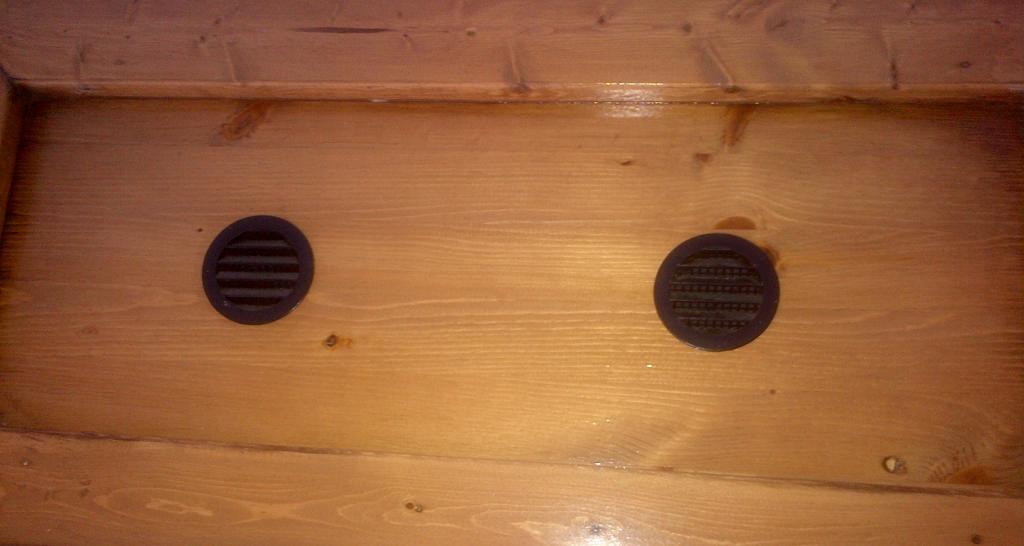
Canopy Example #3
The third example is a canopy that I built for a six foot 180 gallon aquarium.The frame, sides and back were built the same as in the first two examples.I did add additional framing in the middle of the canopy to support the 6 foot span of the top of the canopy. As you can see by the below picture, I had added two sets of mounting rails as I was planning to use two sets of hanging bars for the LED lighting to be used on this aquarium.
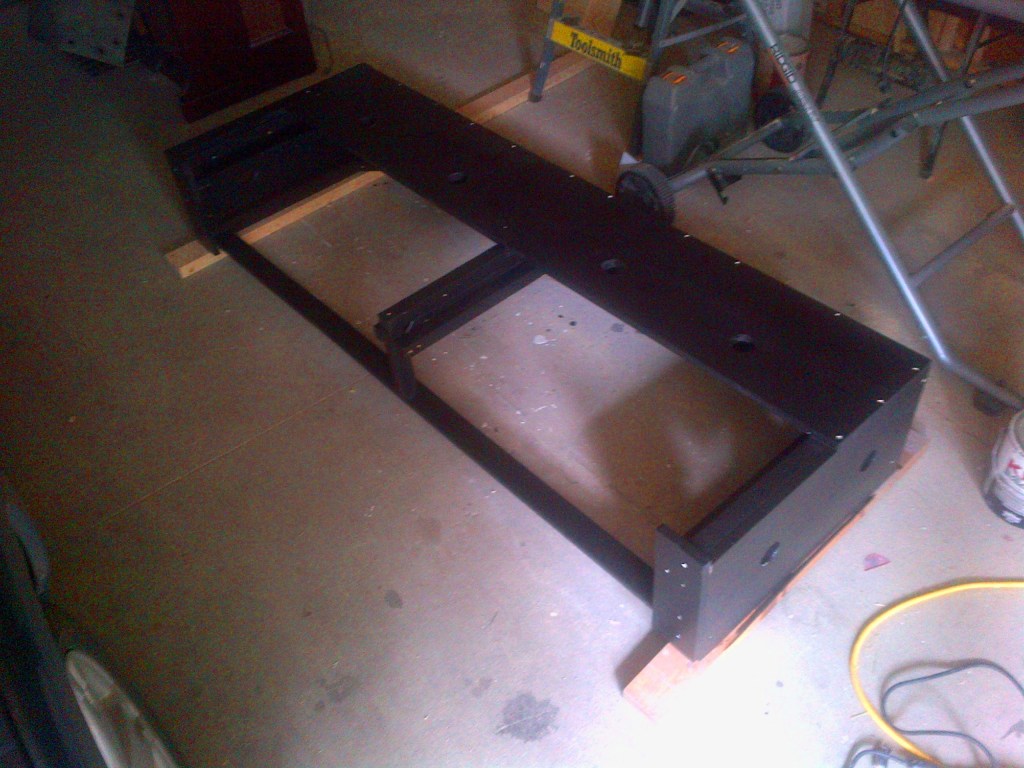
The biggest difference with this canopy is that the doors open out from the center of the front of the canopy and are hinged on each side of the front. The top piece that sits in the opening pictured in the above picture is not actually attached to the top of the canopy making it removable for easy aquarium maintenance when required.The below pictures better illustrate what I am talking about.
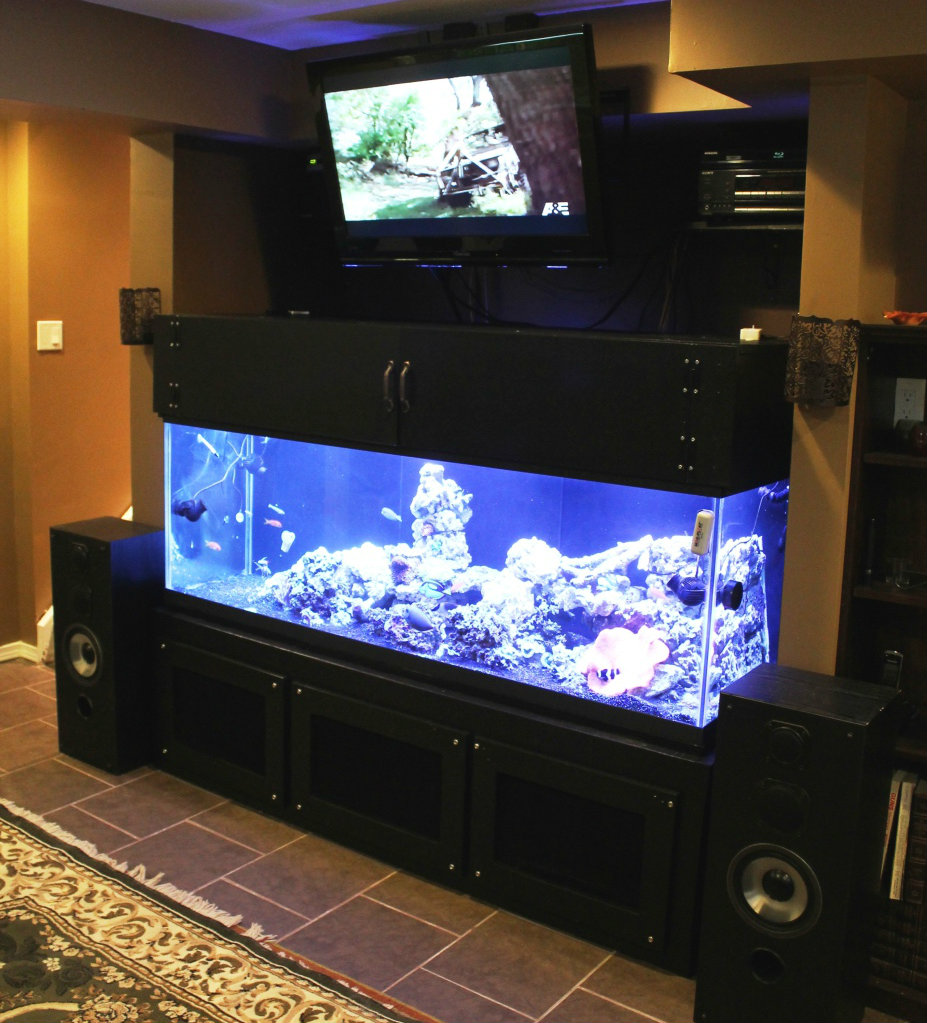
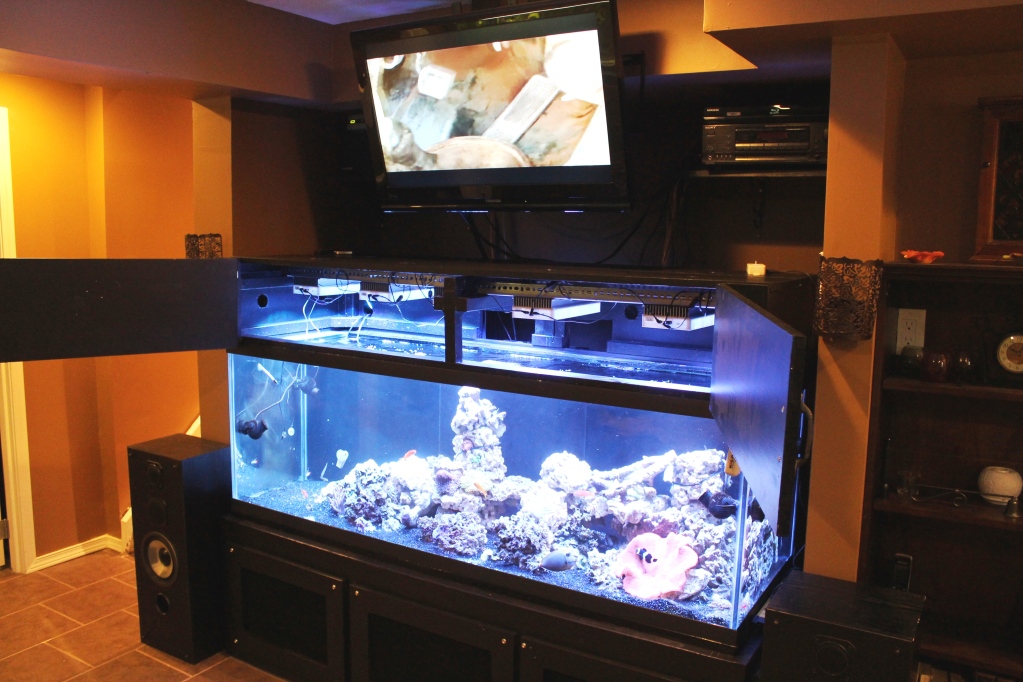
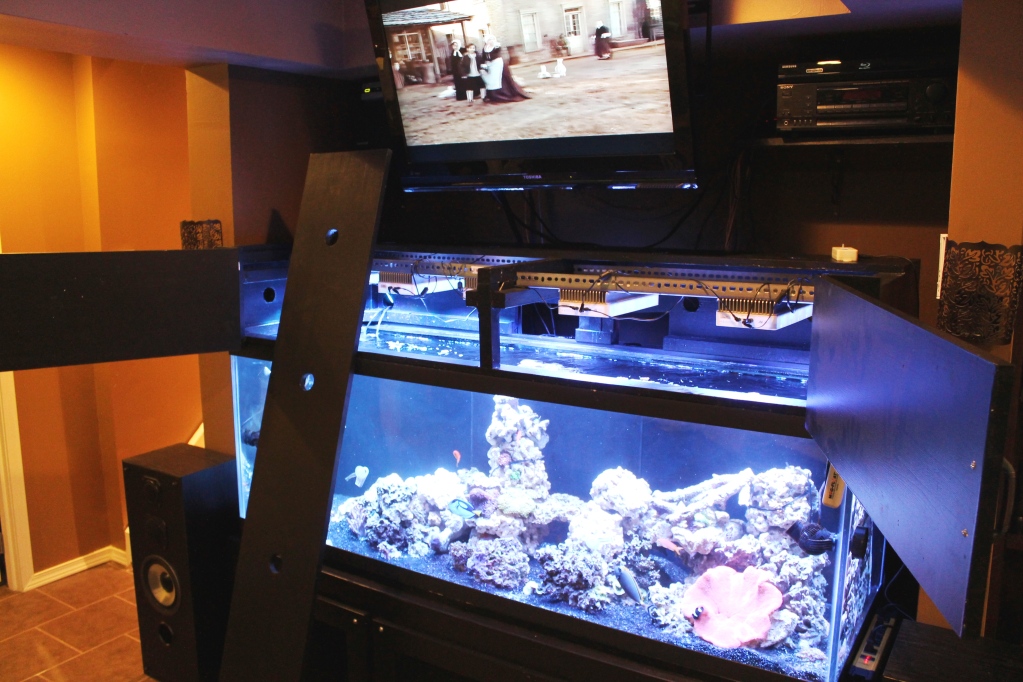
As this aquarium has an external overflow on the back of the aquarium, I had cut out two access holes in the back of the canopy above the overflows for easier access/maintenance to the duriso stand pipes in the overflow without having to remove the canopy to get to them. I had cut this out after I finished building the stand to make things a little easier
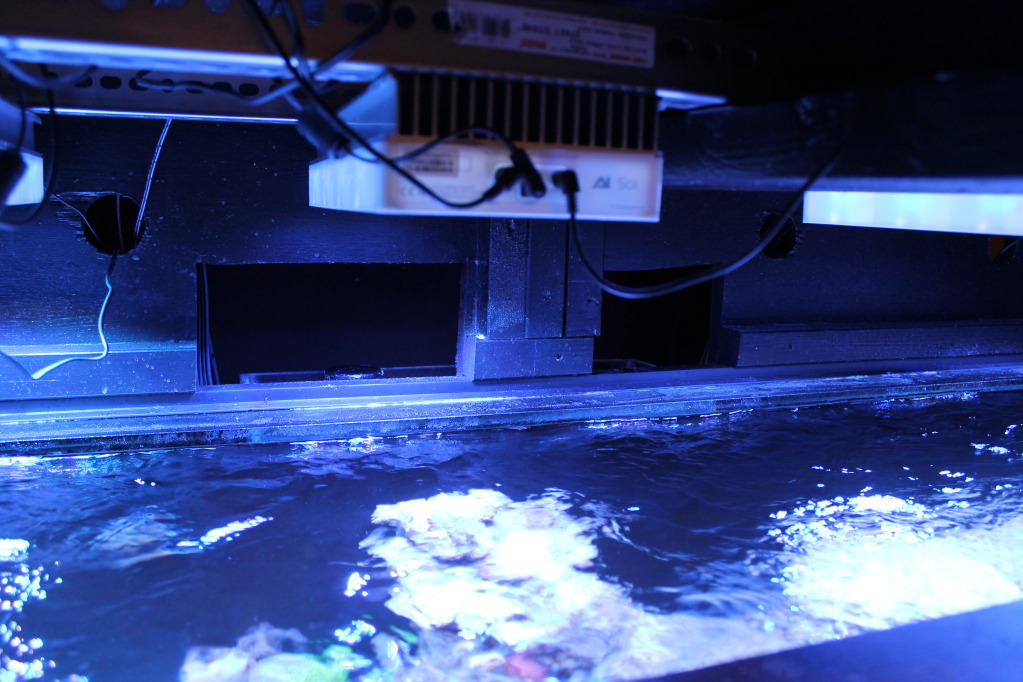
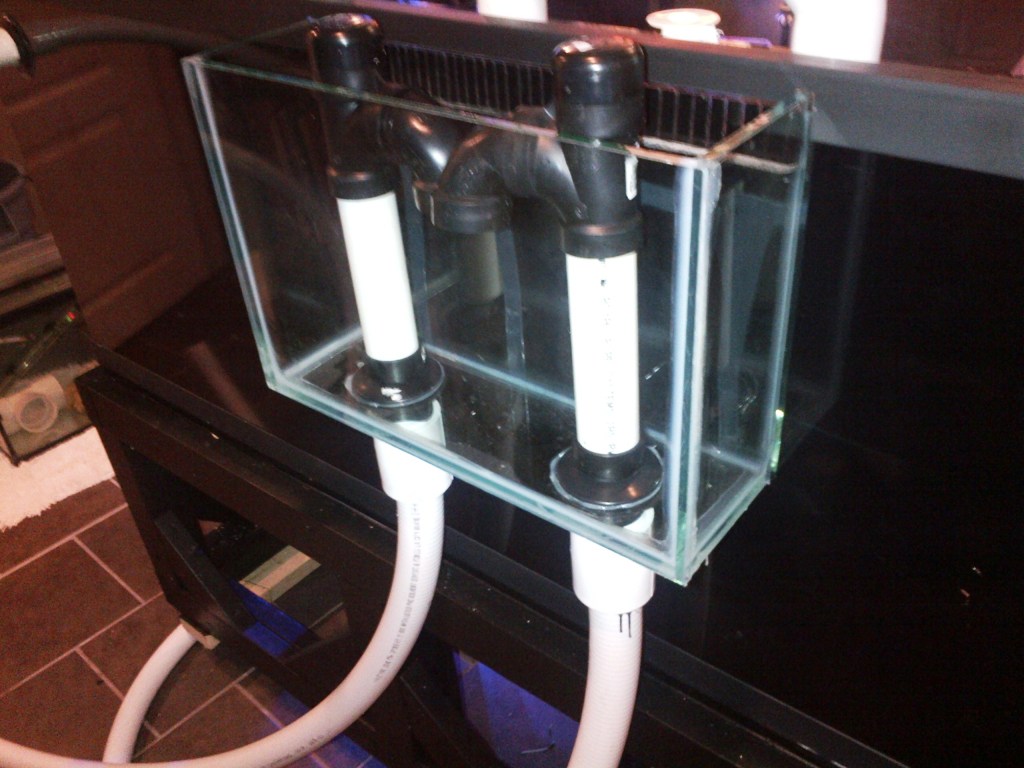
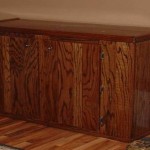
Building a Aquarium Stand
Many hobbyists who are also handy with do it yourself projects will build their own aquarium stands allowing for the exact features, measurements, and overall look they want.
I have always built my stands so I could get a larger sump as well as better internal height for more skimmer options. Below are a few aquarium stands that I have built over the years. If you are somewhat handy at wood working and wood finishing, this should be an easy project for you.
Just a few key things to remember
1 – Make sure the complete edge of the aquarium is supported by the frame of the stand.
2 – Make sure there is direct wood to wood contact from the floor directly straight up to the aquarium.
3 – Assemble the frame together using wood screws and wood glue.
4 – Assemble your stand frame on flooring that you know is level and flat.
5 – Always place a peace of ½ to 1 inch thick rigid foam between the aquarium and the stand.
6 – Carefully plan the height of your stand so you can fit all the equipment inside the stand that you may want.
7- Double check the size / opening for the doors to make sure all the equipment you are planning to up in the stand will fit through the doors.
8- Use the below examples and links at the end of this article to help you plan how to build your tank to ensure it can hold the weight of your full aquarium
As these stands need to hold a lot of weight and must be safe, I do tend to over build them at least a little.
My First Example
The below stand is one that I built for a four foot long 120 gallon aquarium. As I wanted to use a 4 foot long 55 gallon aquarium for the sump, I had to make the stand a few inches longer than four feet. That is why when you look at the below picture of the frame, it will look like it was double framed at both ends.
This is a picture of the frame I built with 2 X 4 peace’s of pine lumber. There were glued together with construction adhesive and screwed with 2 ½ inch construction screws. This is a good example to show what I am referring to when I say direct wood to wood contact from the aquarium frame directly straight down to the floor.
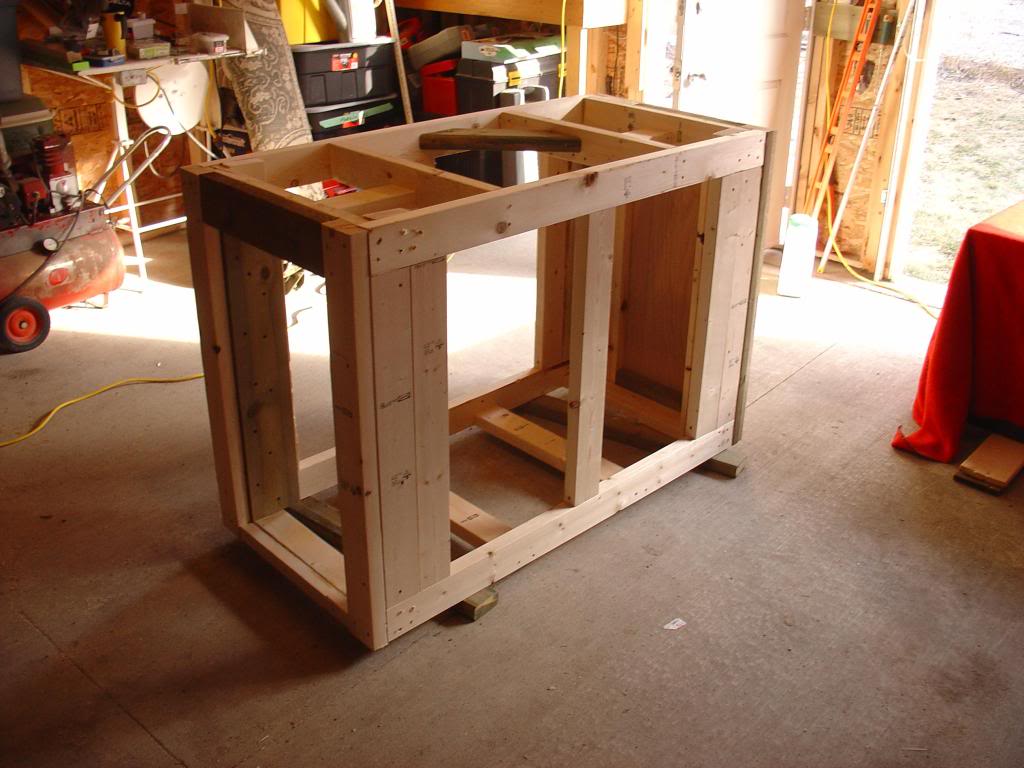
My next step was to cover the frame I made. As I wanted this aquarium stand to match the flooring in the room it was going to sit in, I wanted to cover the frame in ¾ oak. I cut the wood to fit and glued and nailed it to the frame. You can see the openings that I left in the front of the stand for doors to access the sump. The opening on the left hand side is to allow me to remove the sump easily without having to take the tank off the stand. There will also be a door for this end of the stand as well. I left the back of the stand open to allow for greater room when plumbing the sump to the aquarium. I also added some trim to the stand and stained it to match the rest of the furniture in the room it will sit in.
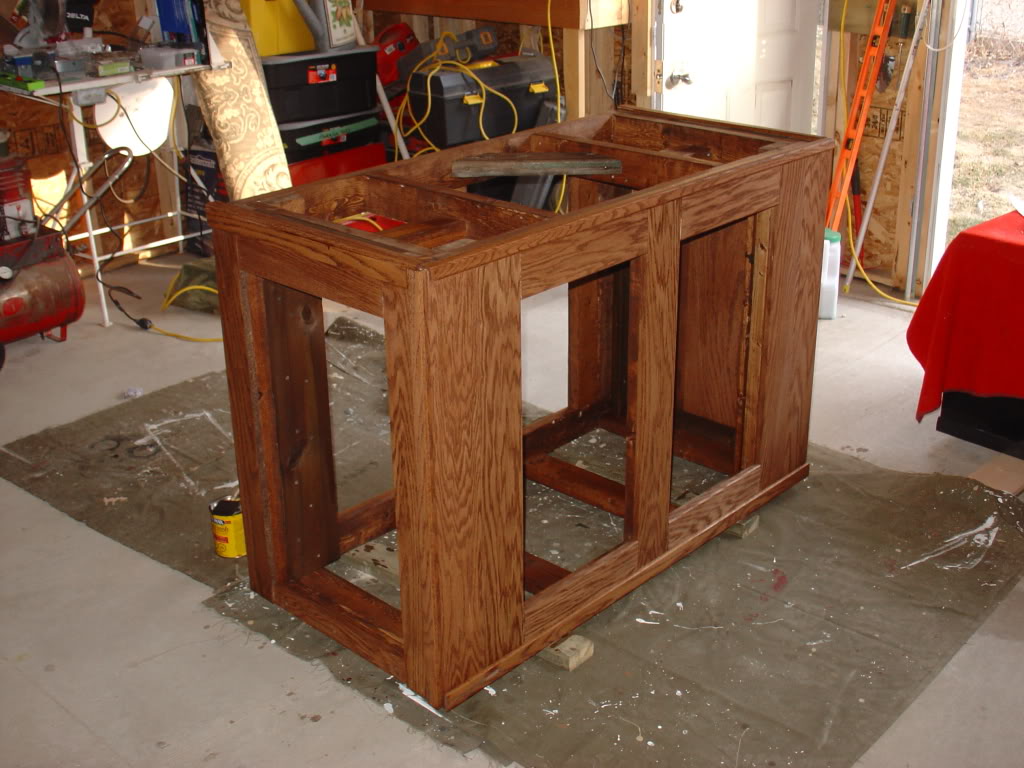
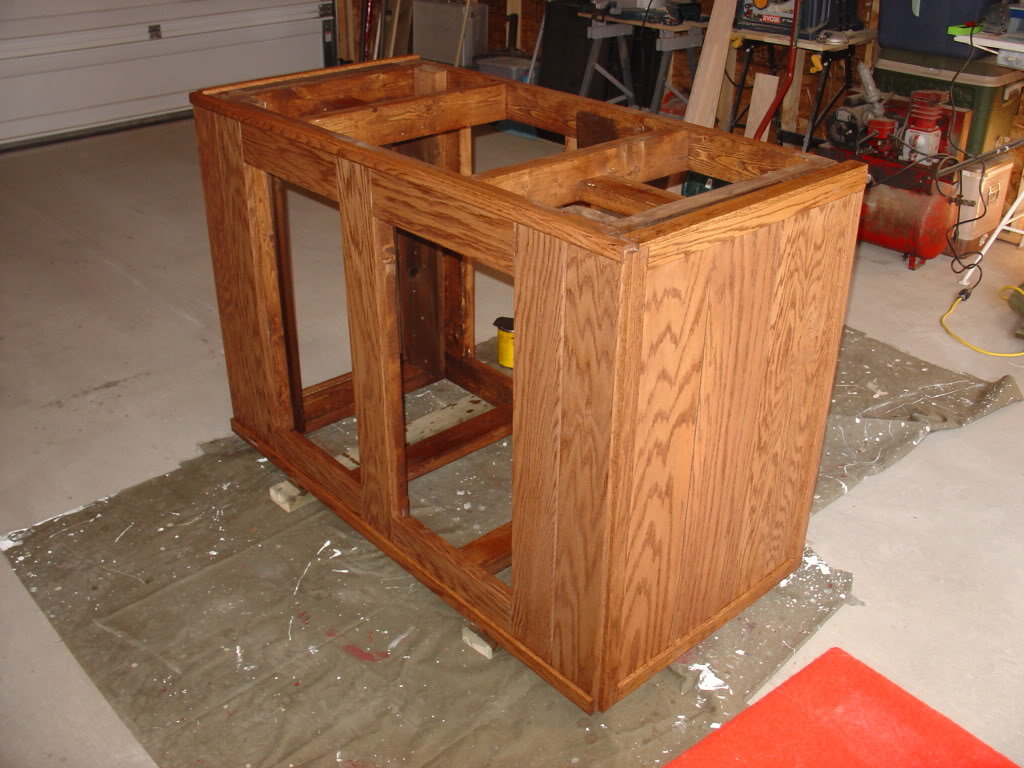
Next I built the all three doors out of the same oak and stained them as well. The whole stand also got 6 coats of the best quality urethane that I could use indoors. I wanted to make sure the wood will be as best protected from moisture that it can be.
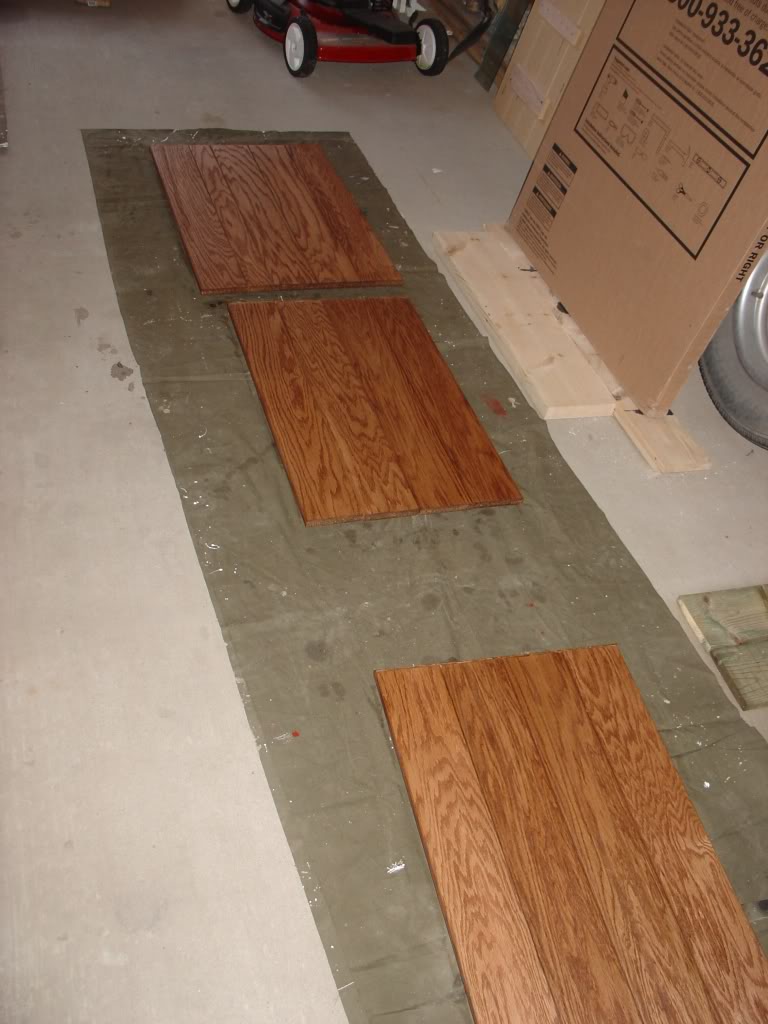
Next I moved the stand into place and set-up the entire system.
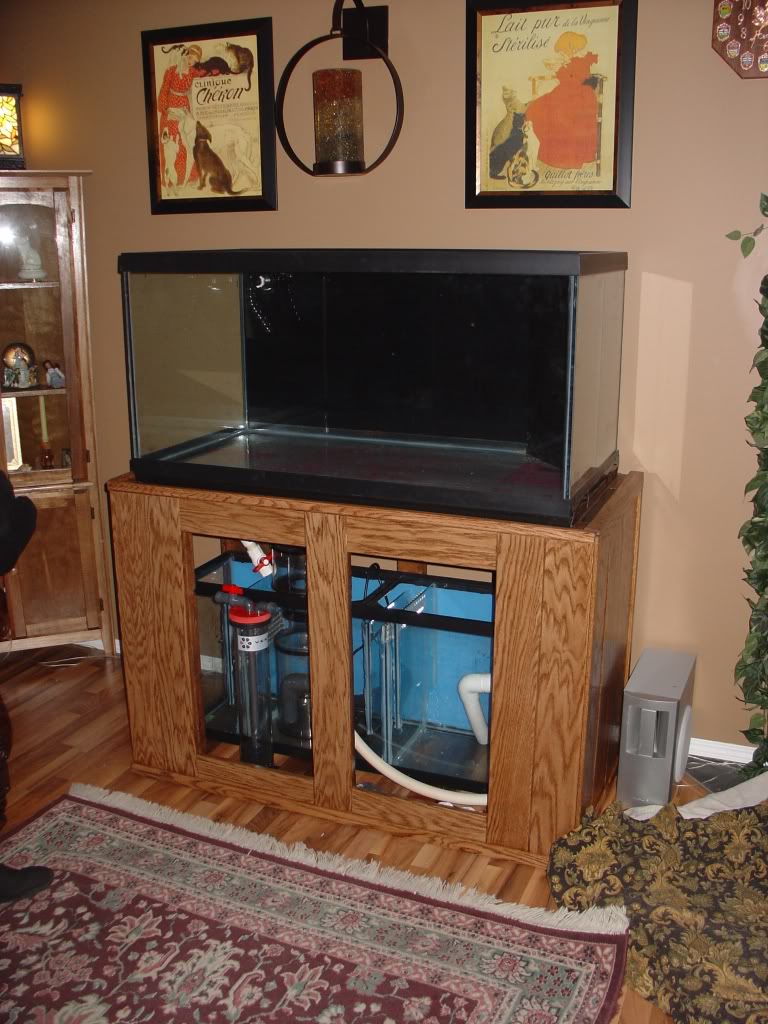
Once all plumbed and tested, I put the doors on and started to enjoy the aquarium. That stand has now been in use for over two years and has been standing up to the ~1,400 lbs sitting on it as well as the moisture.
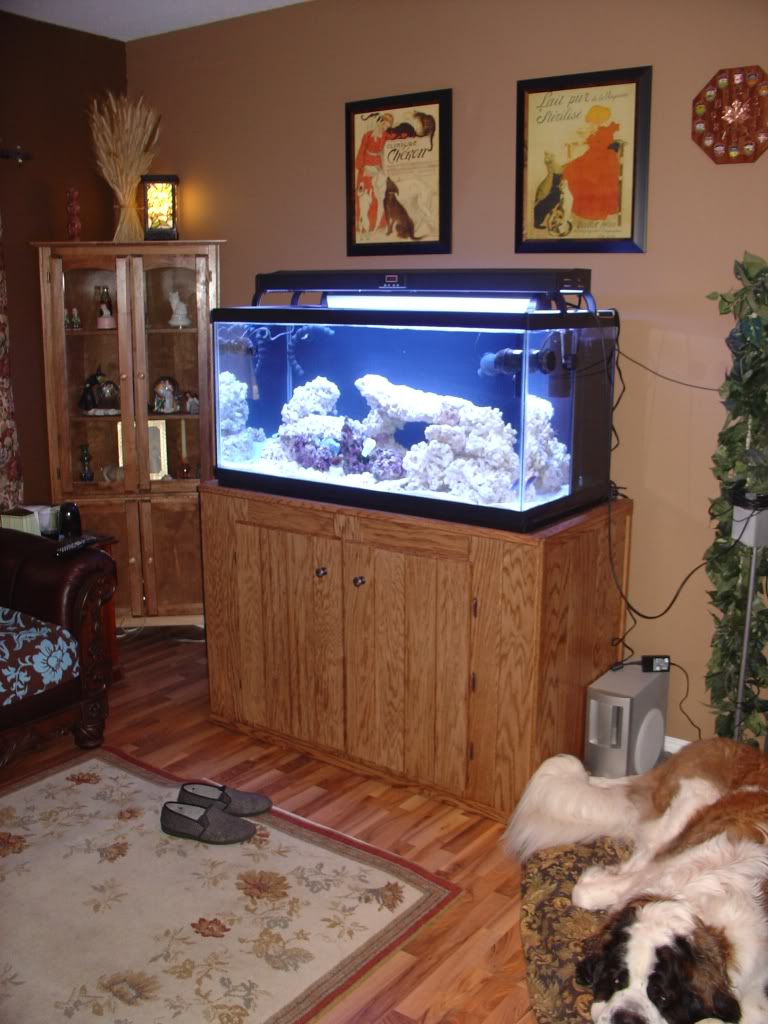
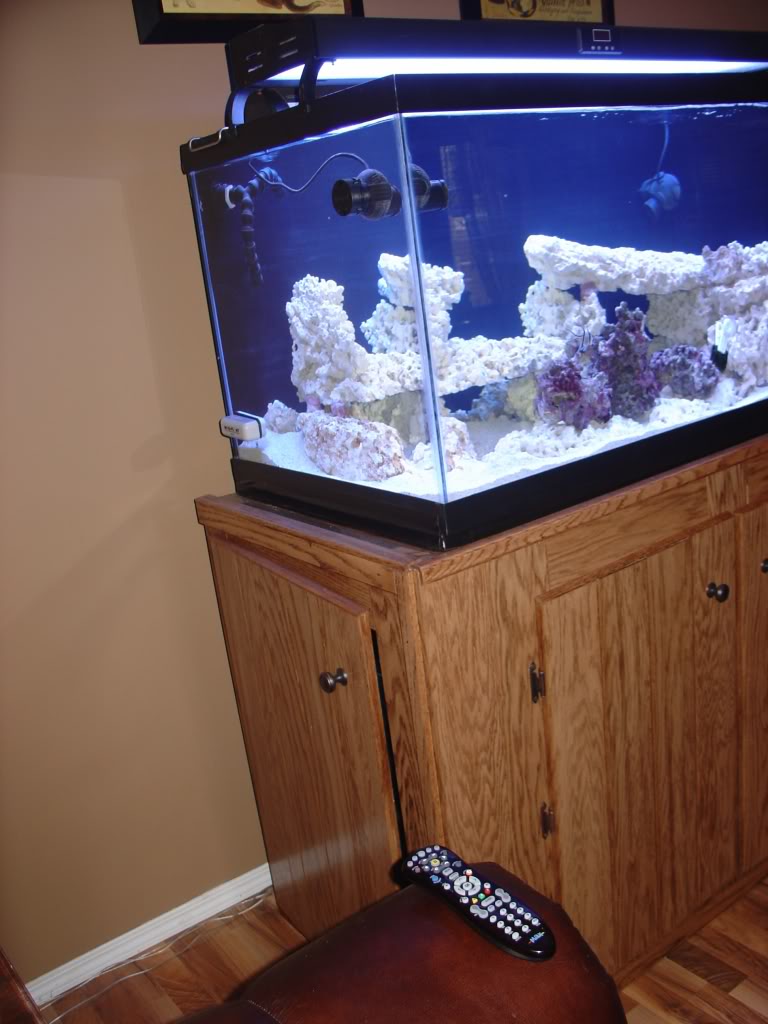
I also built a stand for a fresh water sump-less set-up in almost the same way as this first example above. Below are a few pictures of that stand. The biggest difference on the below stand is that I made a solid wood top out of 3/4 inch plywood.
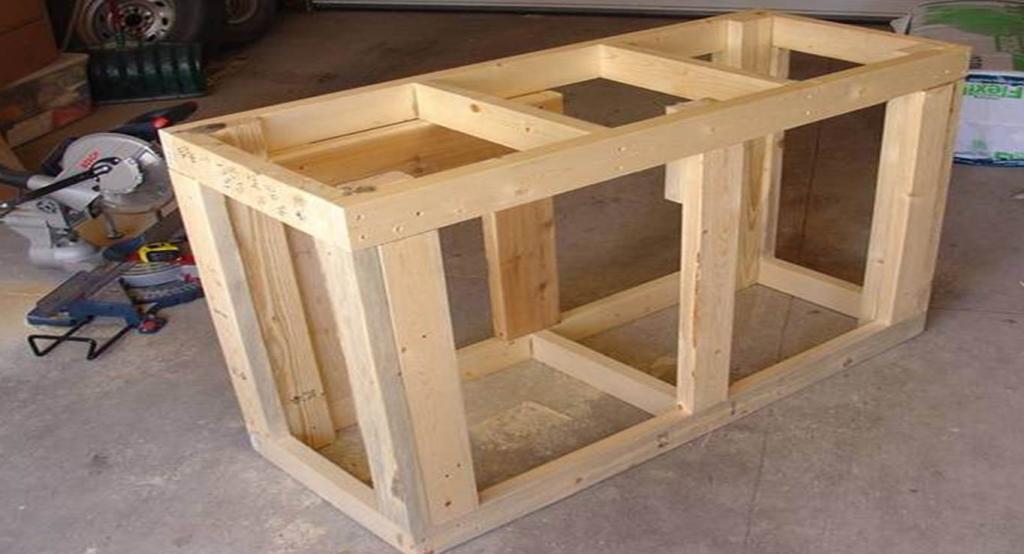
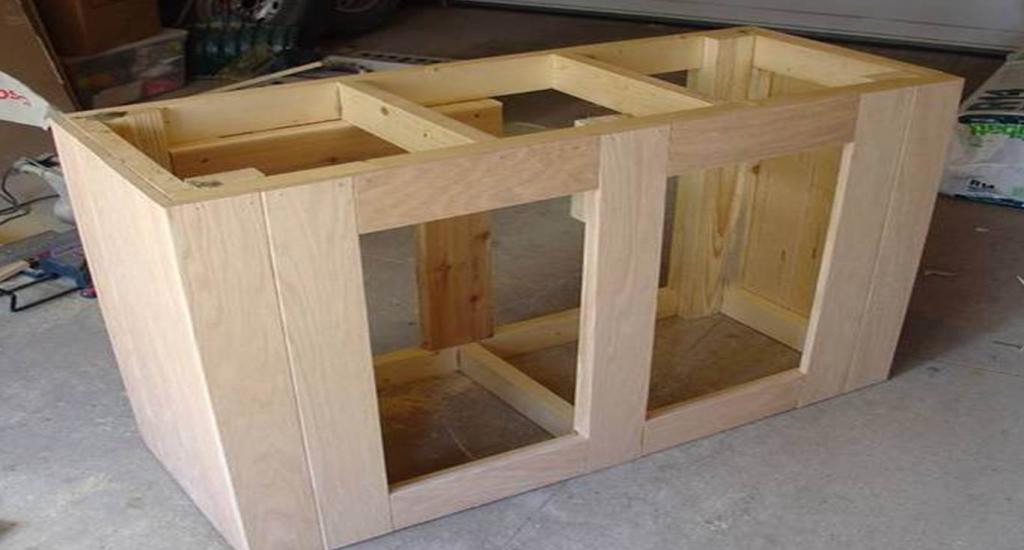
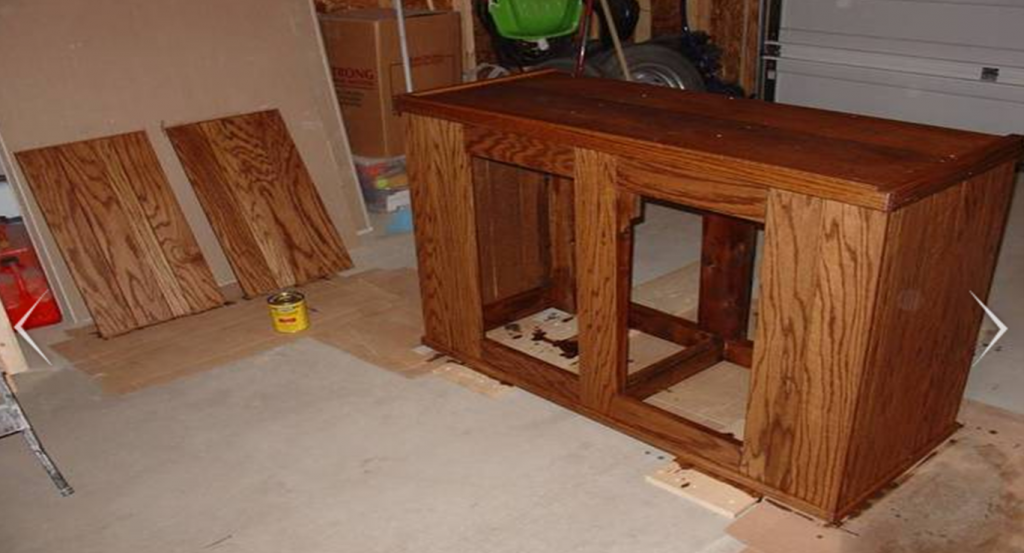
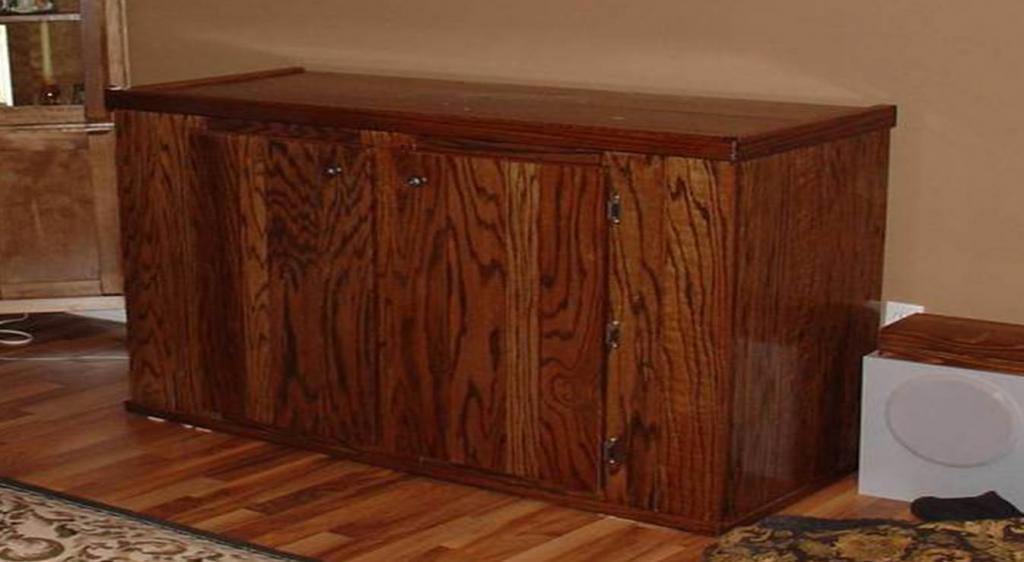
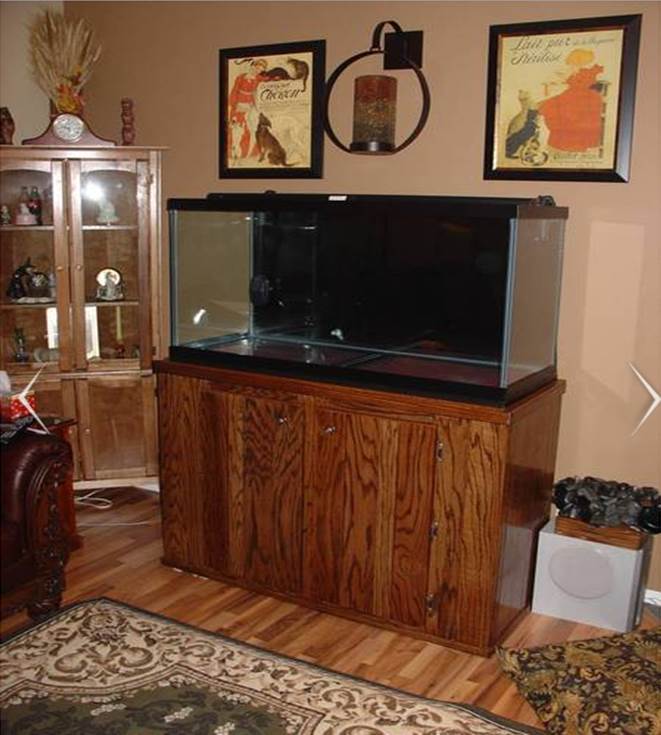
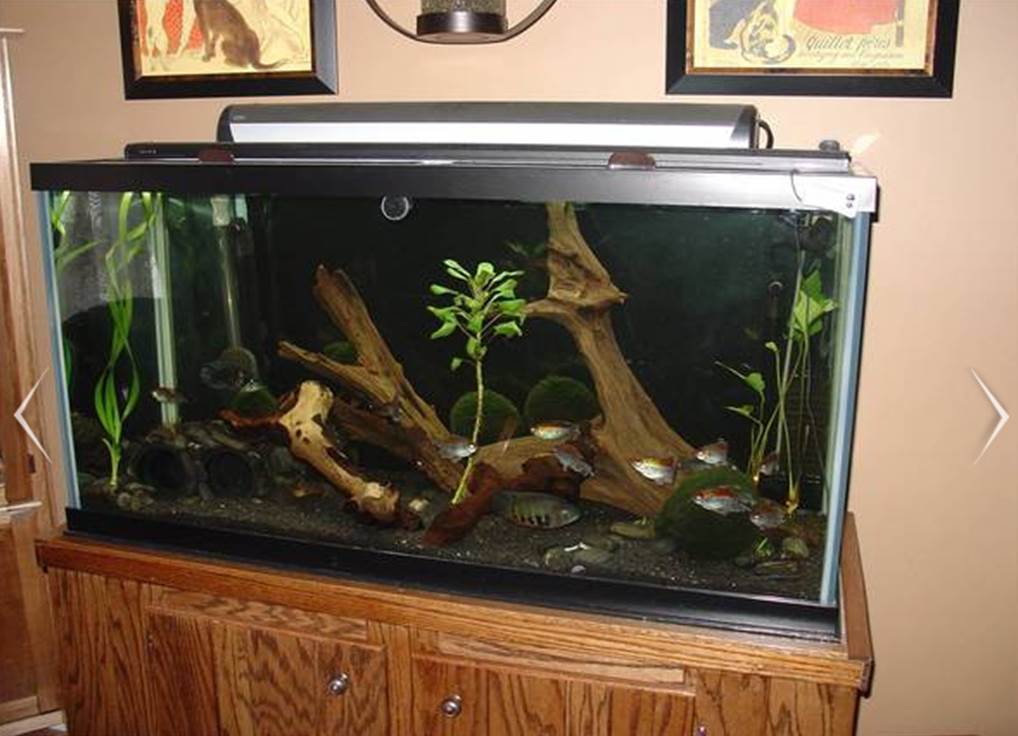
I also used that same design for a stand I built for a older 36 gallon Hagen aquarium that I had a few years back.
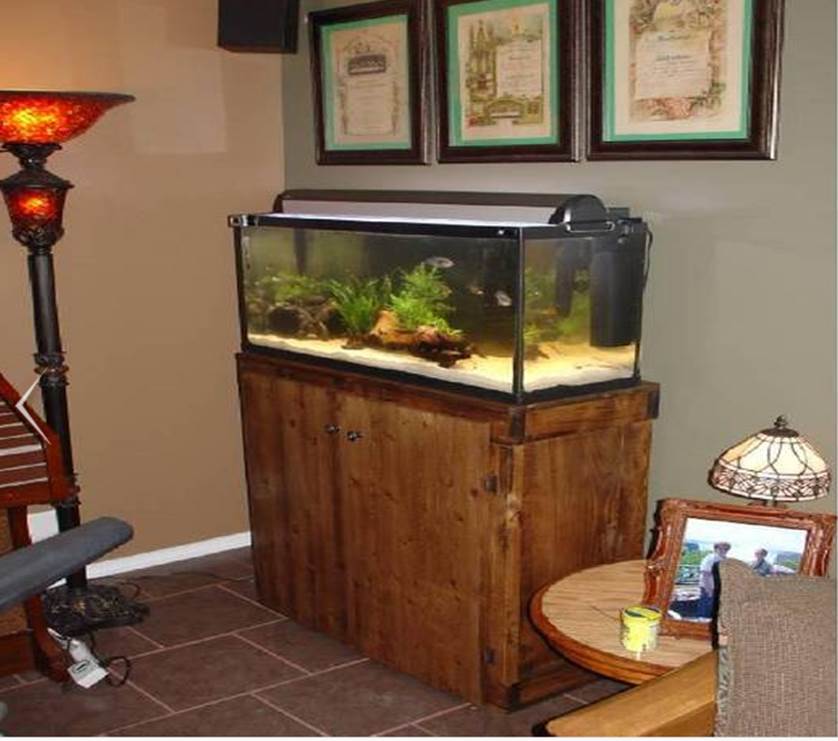
As well as using the same stand design for a 33 gallon set-up I put together for my father.
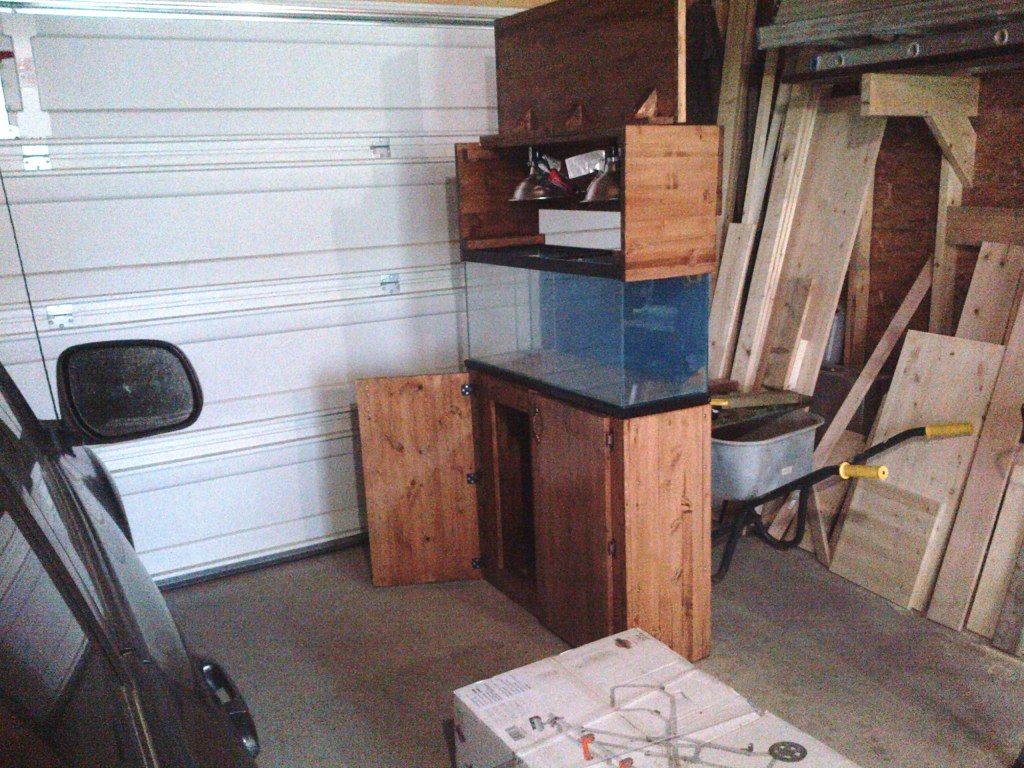
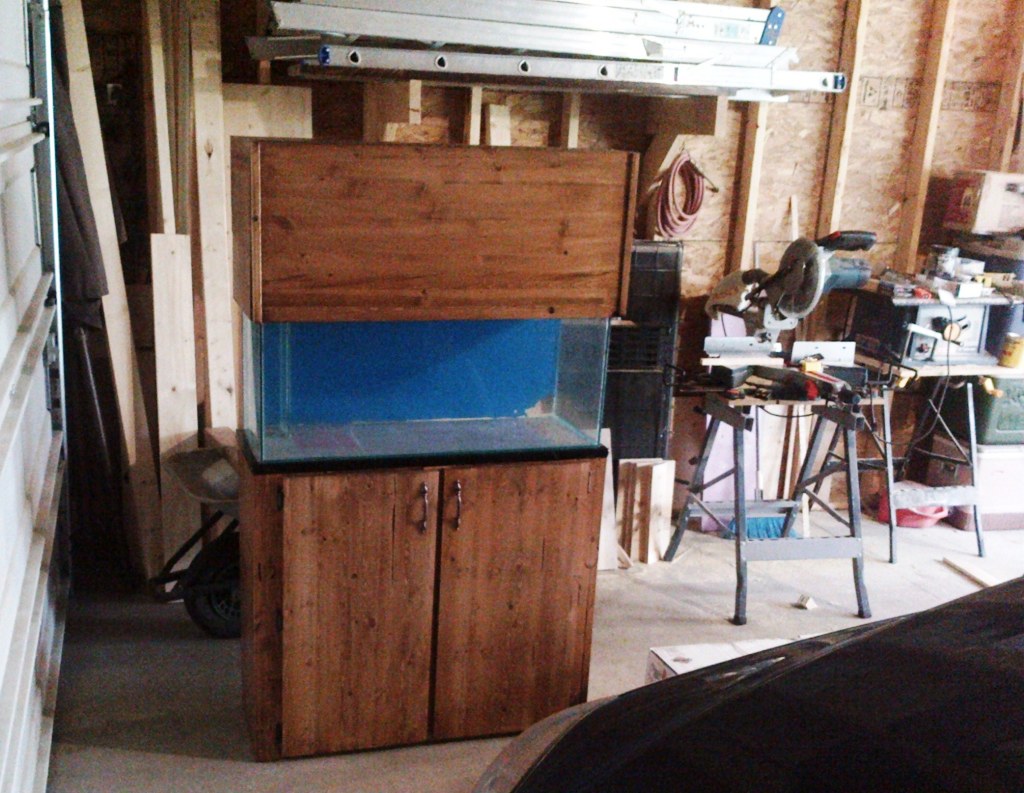
My Second Example
I took a little different approach for my 180 gallon aquarium stand. I doubled up the 2X4s for extra strength. As my sump for this aquarium was going to be in another room, I had no internal height goals to meet, nor did I even need any doors.
The below picture shows the basic frame that I had built. I even added some cross bracing on the up rights along the back and sides of the stand to re enforce the stability.
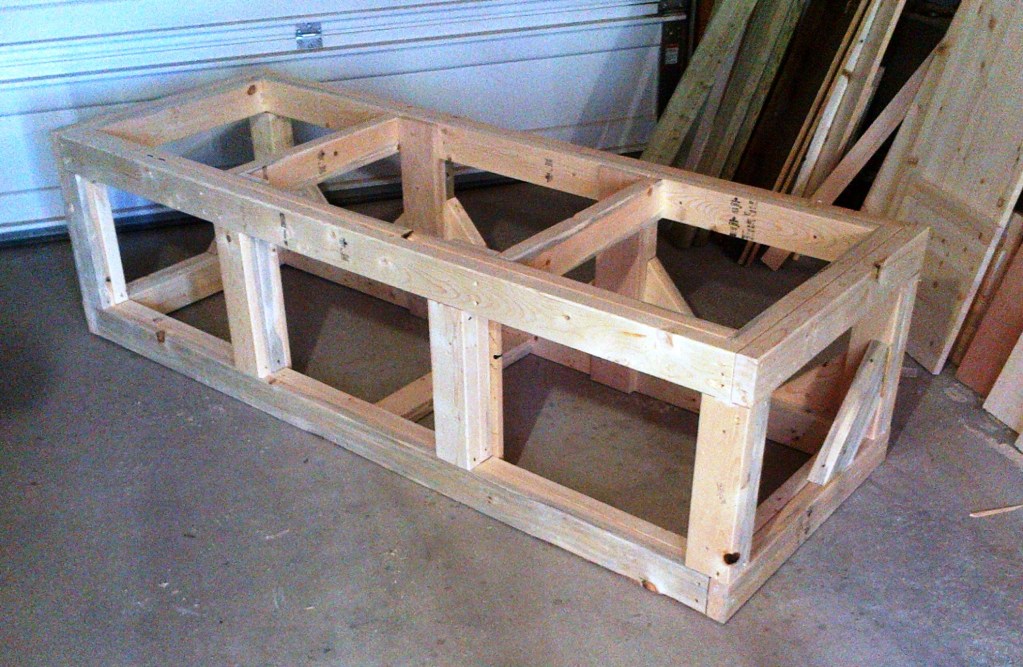
Next I had to use wood filler on all of the screw holes followed by a lot of sanding. Once sanded, 2 coats of primer and 5 coats of paint were applied before the stand was ready. You can even see the peace of rigid styrofoam on the stand for the tank to sit on.
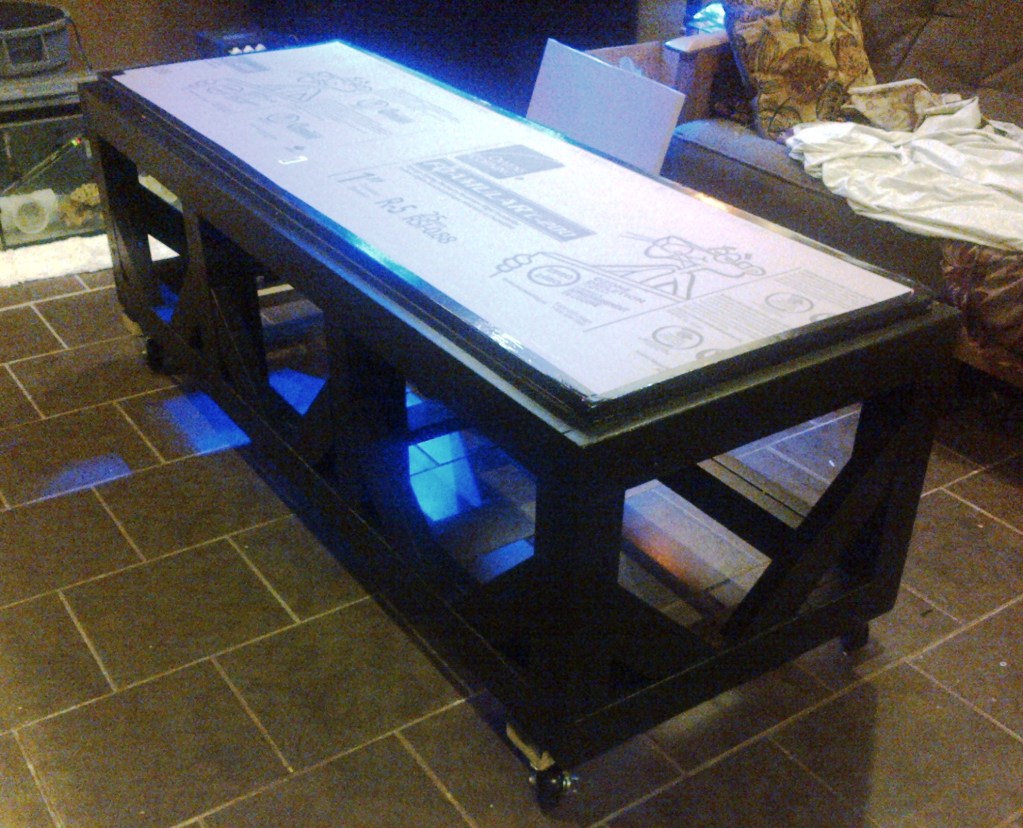
I then placed the aquarium on the stand, moved it in place, and attached the wood and cloth covers to the openings in the stand. This gave me the look I was wanting. This stand has now been in use for well over a year now and has been able to handle the ~2,200lbs of weight that is sitting on it.
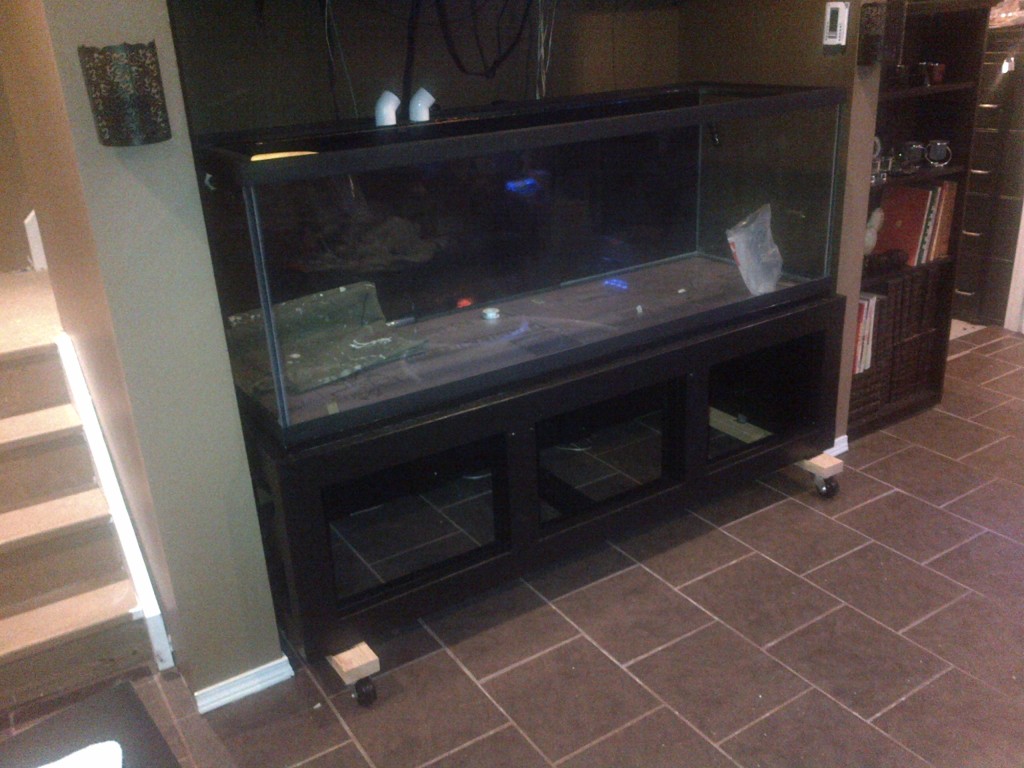
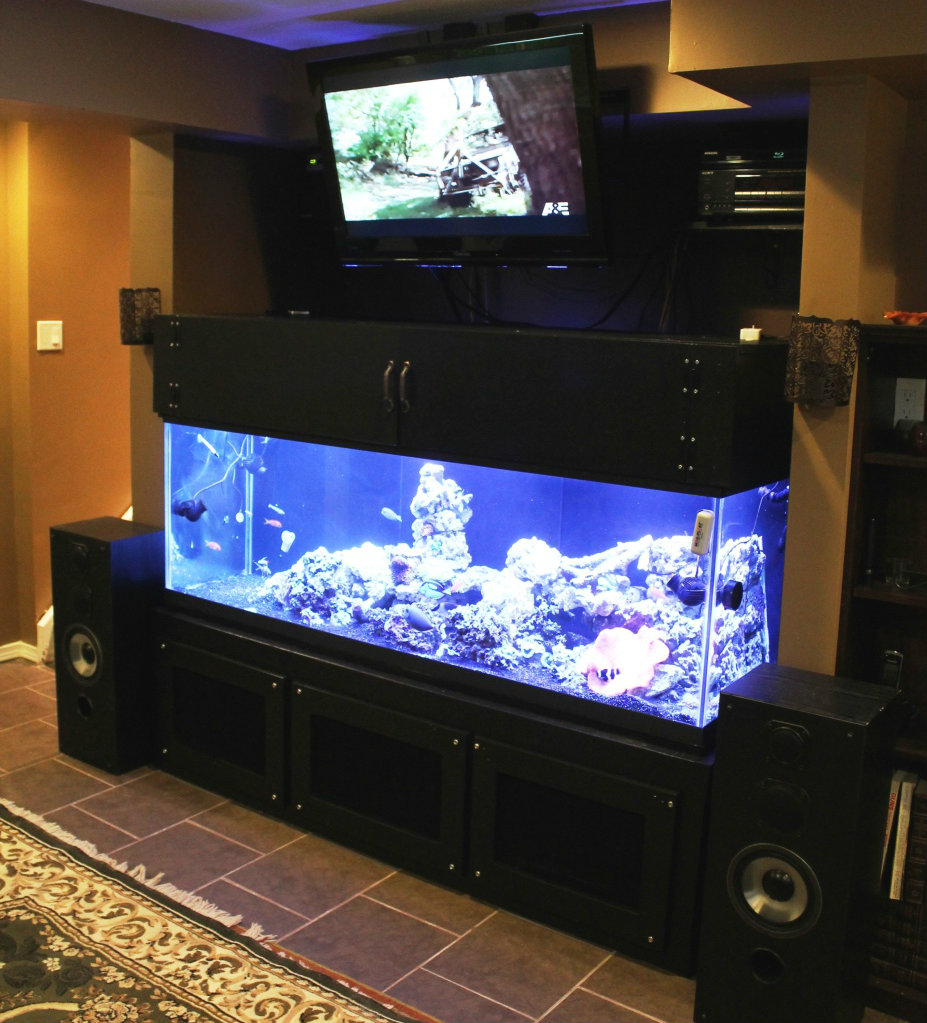
My Third Example
I ran into a very odd challenge with setting up a four foot long, 120 gallon aquarium in our basement. Due to two tight corners, I was limited to the size of stand that I could safety fit through these corners. The problem that I had was that a stand with the required height and width for my sump and skimmer would not fit around those corners. With the hight of the stand being taller than the hight of the aquarium, I could safely move the aquarium down the stairs but not the stand. After giving this a lot of thought, I decided to build a two peace stand that will be held together by a top brace. This would allow me to move the stand down my stairs in two peaces.
I started off by framing each half of the stand. These next two pictures are of the framing. The back of the stand is facing the car in the picture.
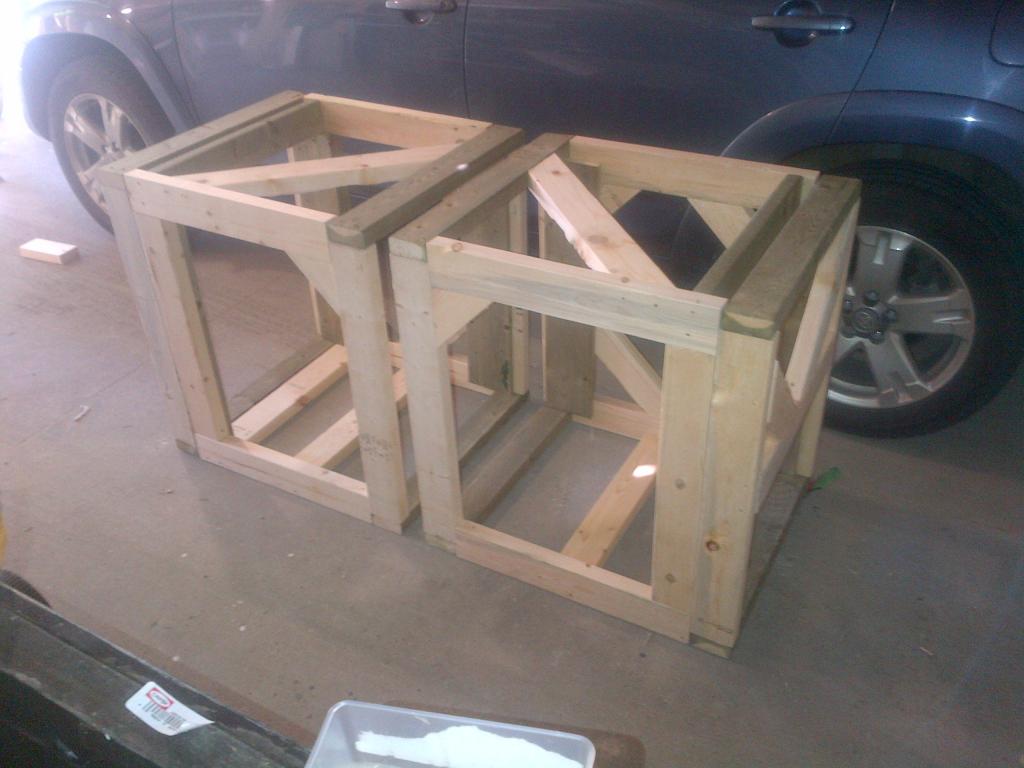
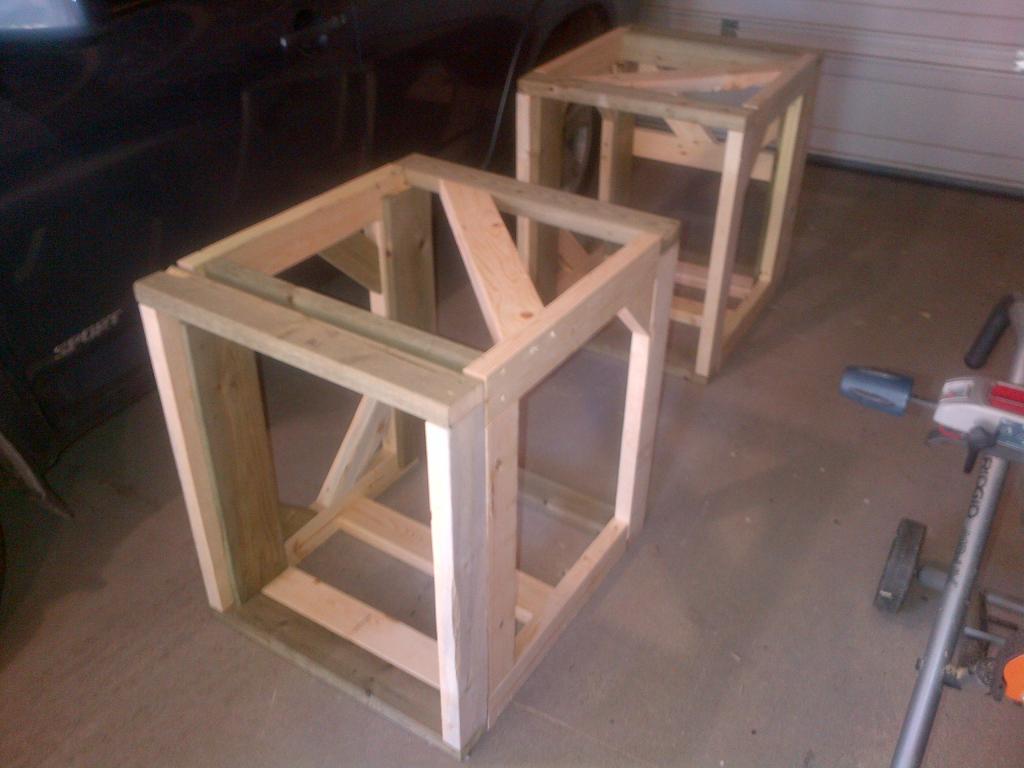
The next two are pictures are of the stand after I sheeted it in pine. As I want this stand to have a black finish, I use paint-able wood filler on all the hole and knots in the wood. The opening on the left hand side of the stand is for a large door to remove the sump if I ever need to.
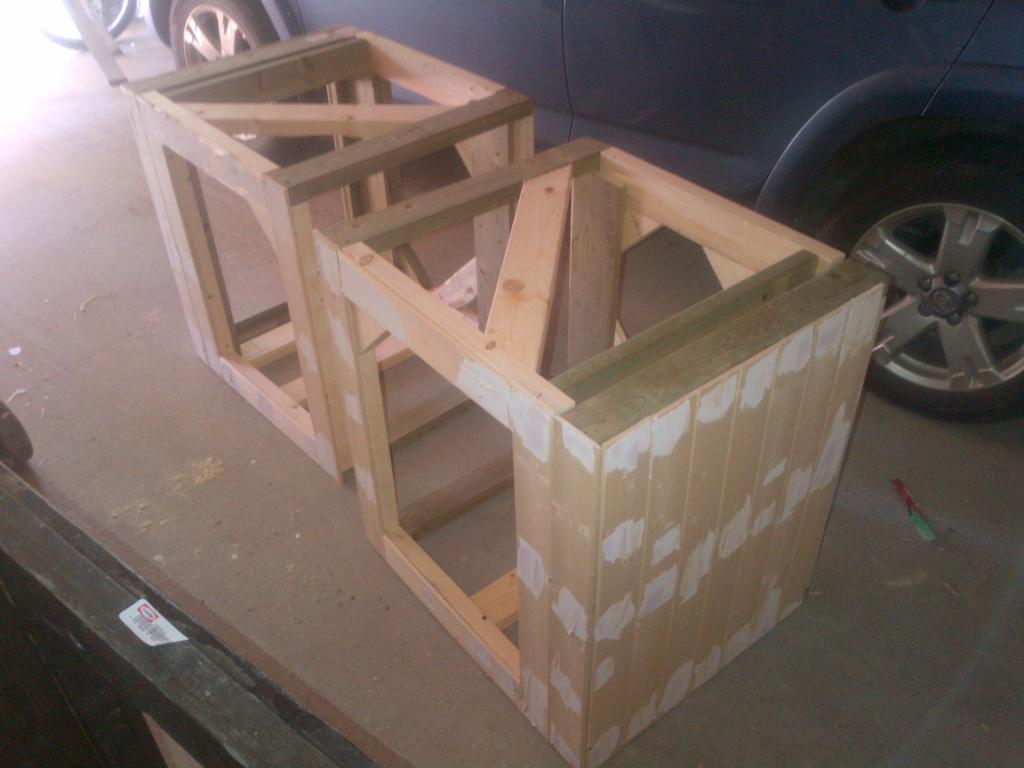
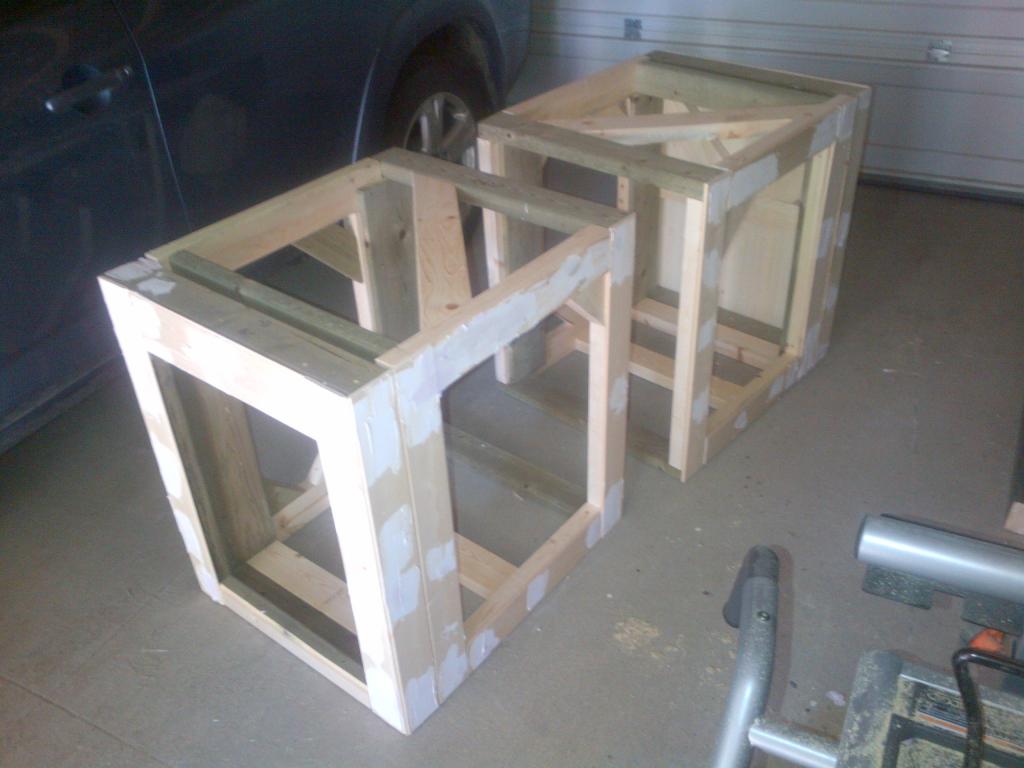
After getting the stand all sanded, primed and painted so I decided to get the top brace peaces cut and make the doors. The below pic shows the top brace peaces sitting in place. The ones on the end were glued & screwed to the top. The ones that run the length of the stand are the ones that hold both pcs of the stand in place
I had to leave a cut out on the back right corner for the drain line. That still leaves 1.75 inches of frame to support the tank in that corner which is more than enough to support the ~1,400 lbs the tank weights. I also wanted a little extra room should I ever need access to the bulk head flange
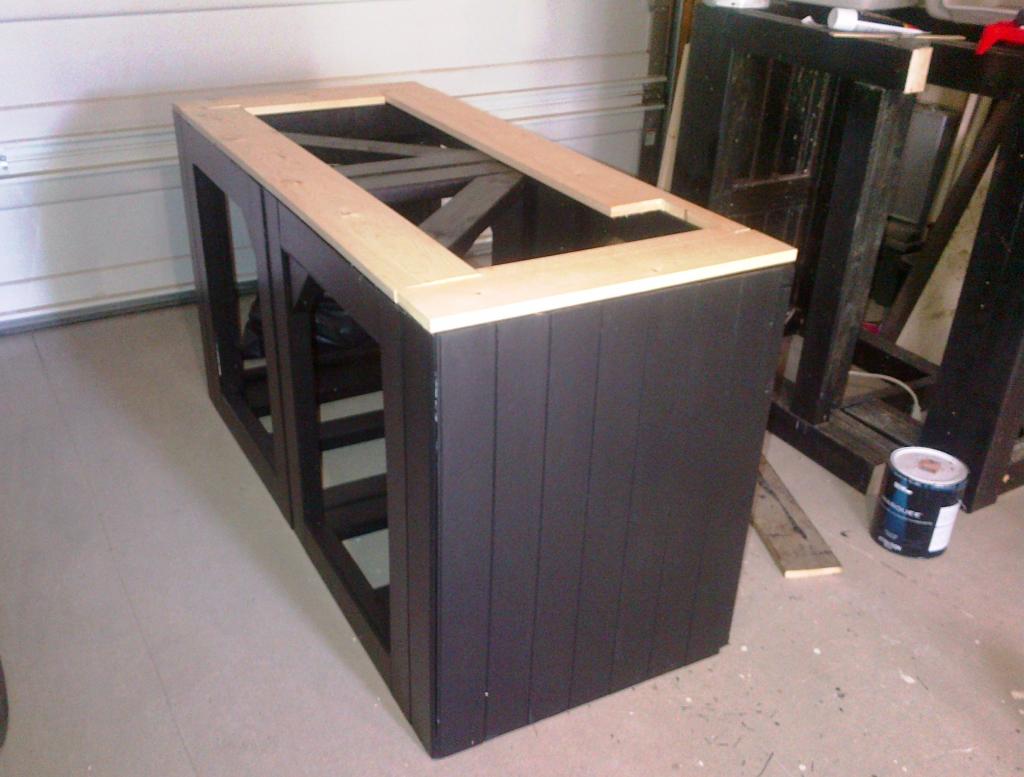
And one of this stand inplace and in use
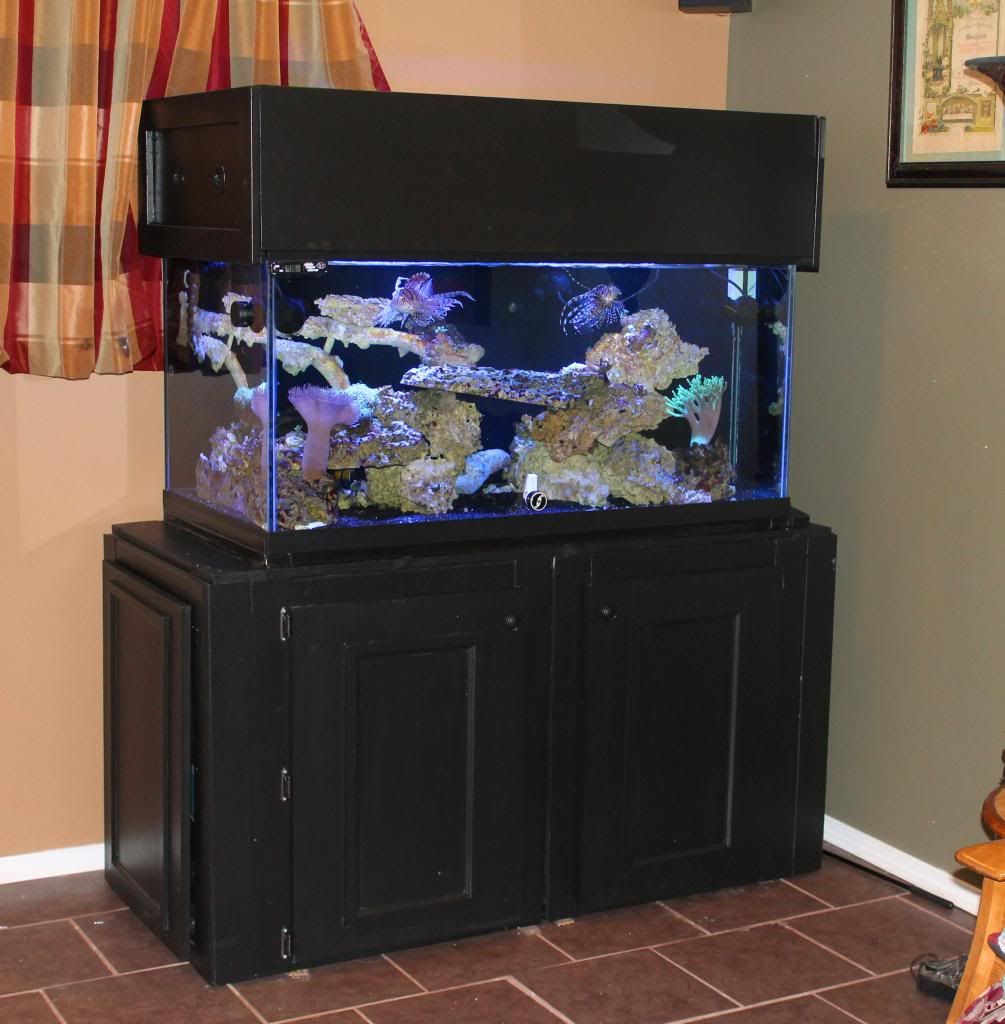
The below links can also help you design and plan a aquarium stand
http://www.fishandtips.com/index.php
http://www.knottyplans.com/index.php?page=1001
Some References
http://diyfishkeepers.com/forum/showthread.php?1081-DIY-aquarium-stand
http://www.cichlid-forum.com/articles/diy_stand.php
http://www.aquariumlife.net/projects/diy-aquarium-stand/75.asp
http://www.reefkeeping.com/joomla/index.php/current-issue/article/29-building-an-aquarium-stand
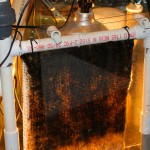
Some Algae Scrubber Basics
Sometimes there just is no substitute for Mother Nature. You could make an argument that this is one of those times. While the use of algae scrubbers as a form of filtration certainly is not a new concept in the hobby, it remains a very effective and easy approach to reducing nitrates and phosphates from your marine aquarium. I thought I would share my approach to building and using an algae scrubber and what I have learned about some algae scrubber basics
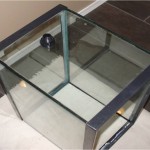
How to Drill a Aquarium
In the past I’ve always bought my tanks drilled if that is what I wanted. One day I asked myself, “why”. So I figured I would learn how to drill a tank and try it out for myself. No sense in paying extra for something that I can do myself. I practiced on a pc of extra glass I had left over from making my sump, just to be safe before trying it on one of my tanks. Here’s how I did it.
Continue reading
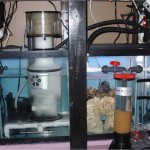
Some Sump Basics
Simply worded, a sump is just a secondary tank that is set-up and linked into a main / display tank as an option for placing equipment as well as providing filtration for the main tank.
If I have learned anything in this hobby it is that there are many many different ways to achieve a healthy and thriving tank. This could not be any truer with how you choose to set up a sump. Likely the best way to approach this topic is to describe the factors that I learned which go into designing your sump and then show you how I set up my sump just as one example. I hope you will find these sump basics helpful.
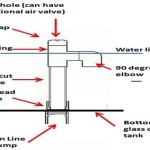
Aquarium Plumbing Basics
When you set out to plumb an aquarium set-up with a sump, the more planning / thought you put into the original set-up, the better it will be in the long run. This is not a very hard thing to do at all, if you focus on the basics and understand them. I tend to think of it in flowing different steps: A) Planning of your flow rates, B) planning the material types and sizes, and C) installation / set-up of the plumbing system. All of what you are about to read below is based on my experiences with various data from some North American manufactures of plumbing products (IPEX, Canplas, and Boshart) which is also detailed in the American Society for Testing and Materials (ASTM) standards.
I will explain what I mean by each step then I will show you examples from one of my reef tanks